Strategic Marketing Evaluation of BYD
VerifiedAdded on 2020/12/09
|21
|5720
|107
Report
AI Summary
This report provides a comprehensive strategic marketing evaluation of BYD, a leading renewable energy and high-tech company. It analyzes BYD's resources, including tangible and intangible assets, identifies key competitors, and examines customer analysis. The report also explores innovation strategies, social and ethical considerations, and potential future challenges BYD may face, including financial constraints, competition, and market trends. Desklib provides past papers and solved assignments for students.
Contribute Materials
Your contribution can guide someone’s learning journey. Share your
documents today.
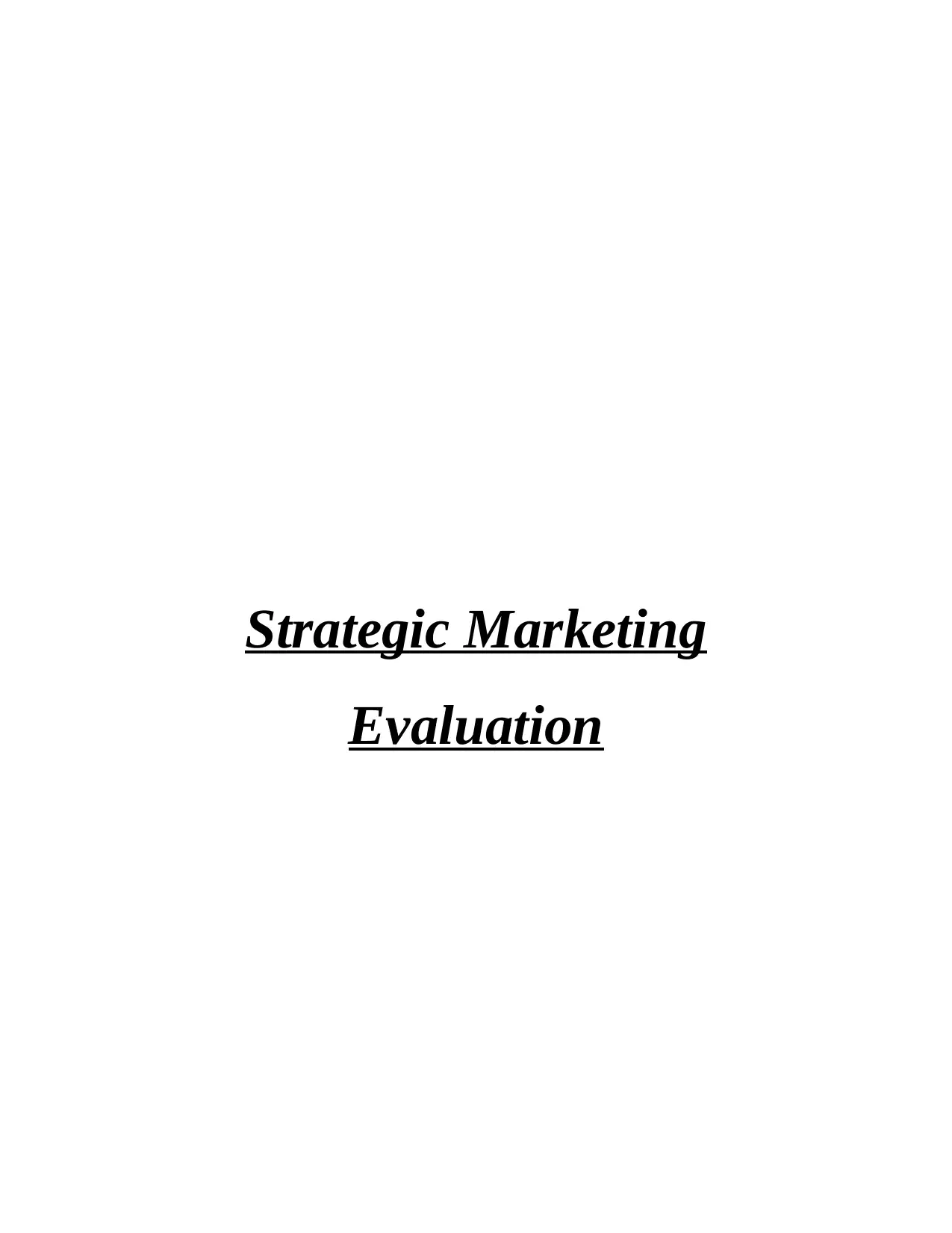
Strategic Marketing
Evaluation
Evaluation
Secure Best Marks with AI Grader
Need help grading? Try our AI Grader for instant feedback on your assignments.
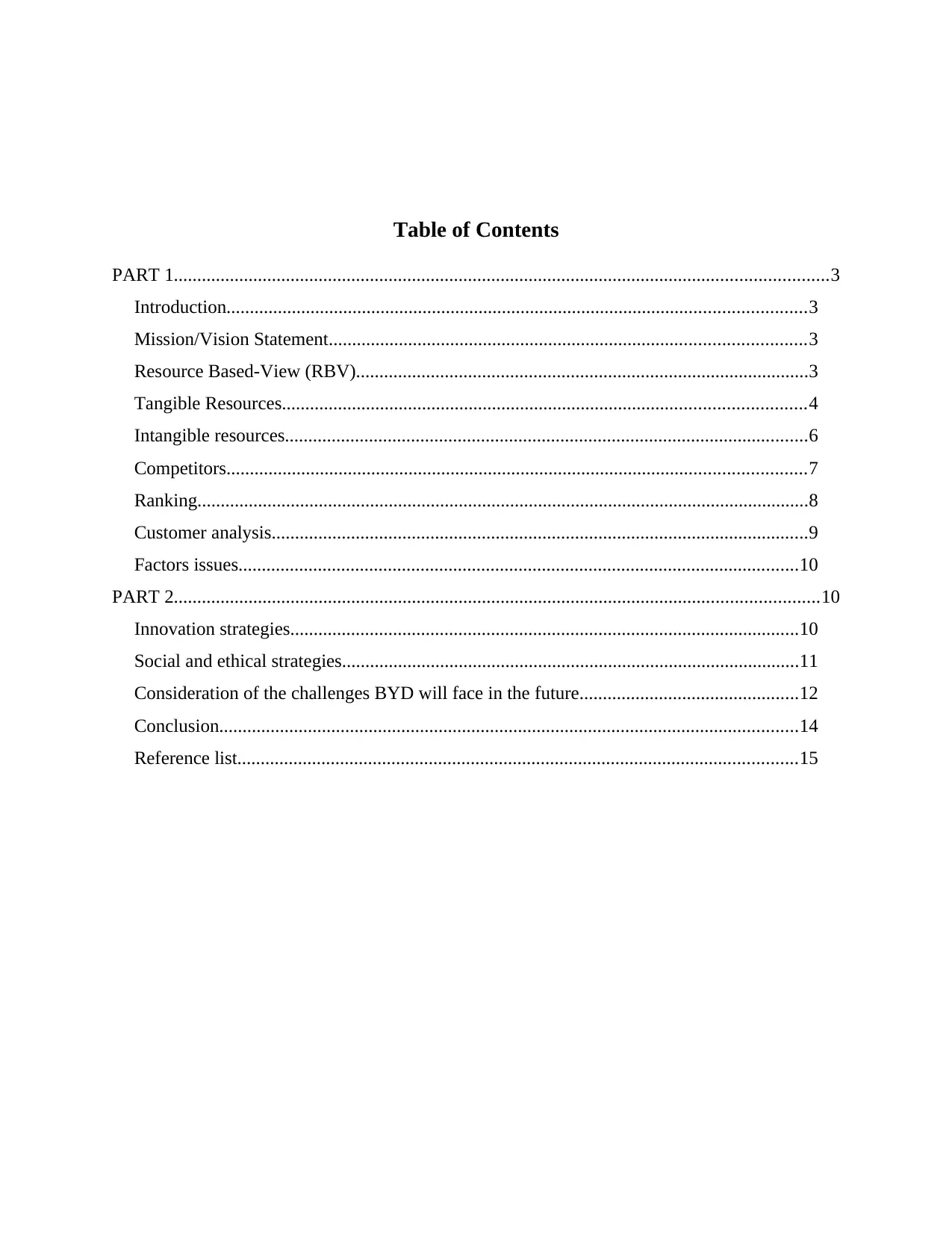
Table of Contents
PART 1............................................................................................................................................3
Introduction............................................................................................................................3
Mission/Vision Statement......................................................................................................3
Resource Based-View (RBV).................................................................................................3
Tangible Resources................................................................................................................4
Intangible resources................................................................................................................6
Competitors............................................................................................................................7
Ranking...................................................................................................................................8
Customer analysis...................................................................................................................9
Factors issues........................................................................................................................10
PART 2..........................................................................................................................................10
Innovation strategies.............................................................................................................10
Social and ethical strategies..................................................................................................11
Consideration of the challenges BYD will face in the future...............................................12
Conclusion............................................................................................................................14
Reference list........................................................................................................................15
PART 1............................................................................................................................................3
Introduction............................................................................................................................3
Mission/Vision Statement......................................................................................................3
Resource Based-View (RBV).................................................................................................3
Tangible Resources................................................................................................................4
Intangible resources................................................................................................................6
Competitors............................................................................................................................7
Ranking...................................................................................................................................8
Customer analysis...................................................................................................................9
Factors issues........................................................................................................................10
PART 2..........................................................................................................................................10
Innovation strategies.............................................................................................................10
Social and ethical strategies..................................................................................................11
Consideration of the challenges BYD will face in the future...............................................12
Conclusion............................................................................................................................14
Reference list........................................................................................................................15
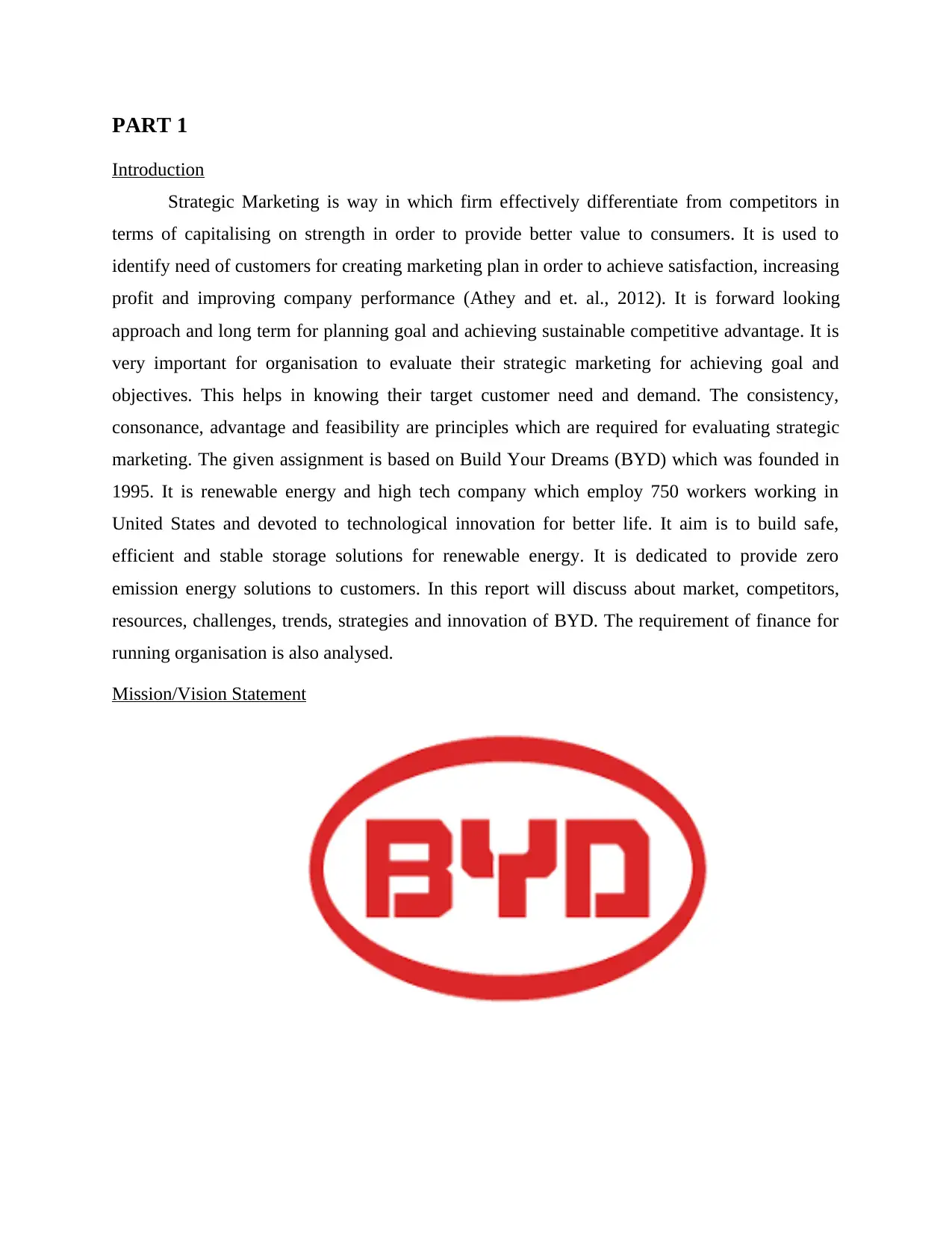
PART 1
Introduction
Strategic Marketing is way in which firm effectively differentiate from competitors in
terms of capitalising on strength in order to provide better value to consumers. It is used to
identify need of customers for creating marketing plan in order to achieve satisfaction, increasing
profit and improving company performance (Athey and et. al., 2012). It is forward looking
approach and long term for planning goal and achieving sustainable competitive advantage. It is
very important for organisation to evaluate their strategic marketing for achieving goal and
objectives. This helps in knowing their target customer need and demand. The consistency,
consonance, advantage and feasibility are principles which are required for evaluating strategic
marketing. The given assignment is based on Build Your Dreams (BYD) which was founded in
1995. It is renewable energy and high tech company which employ 750 workers working in
United States and devoted to technological innovation for better life. It aim is to build safe,
efficient and stable storage solutions for renewable energy. It is dedicated to provide zero
emission energy solutions to customers. In this report will discuss about market, competitors,
resources, challenges, trends, strategies and innovation of BYD. The requirement of finance for
running organisation is also analysed.
Mission/Vision Statement
Introduction
Strategic Marketing is way in which firm effectively differentiate from competitors in
terms of capitalising on strength in order to provide better value to consumers. It is used to
identify need of customers for creating marketing plan in order to achieve satisfaction, increasing
profit and improving company performance (Athey and et. al., 2012). It is forward looking
approach and long term for planning goal and achieving sustainable competitive advantage. It is
very important for organisation to evaluate their strategic marketing for achieving goal and
objectives. This helps in knowing their target customer need and demand. The consistency,
consonance, advantage and feasibility are principles which are required for evaluating strategic
marketing. The given assignment is based on Build Your Dreams (BYD) which was founded in
1995. It is renewable energy and high tech company which employ 750 workers working in
United States and devoted to technological innovation for better life. It aim is to build safe,
efficient and stable storage solutions for renewable energy. It is dedicated to provide zero
emission energy solutions to customers. In this report will discuss about market, competitors,
resources, challenges, trends, strategies and innovation of BYD. The requirement of finance for
running organisation is also analysed.
Mission/Vision Statement
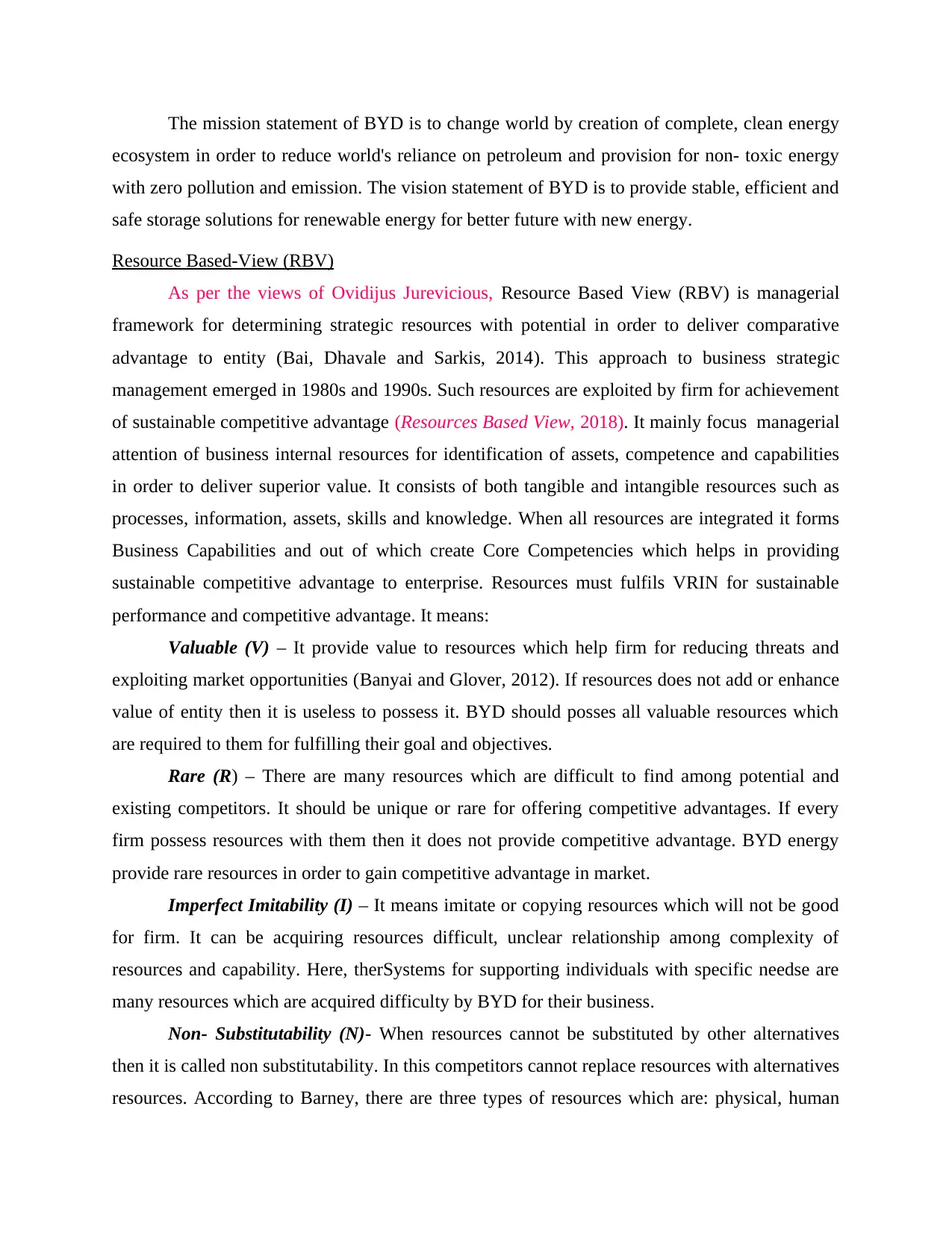
The mission statement of BYD is to change world by creation of complete, clean energy
ecosystem in order to reduce world's reliance on petroleum and provision for non- toxic energy
with zero pollution and emission. The vision statement of BYD is to provide stable, efficient and
safe storage solutions for renewable energy for better future with new energy.
Resource Based-View (RBV)
As per the views of Ovidijus Jurevicious, Resource Based View (RBV) is managerial
framework for determining strategic resources with potential in order to deliver comparative
advantage to entity (Bai, Dhavale and Sarkis, 2014). This approach to business strategic
management emerged in 1980s and 1990s. Such resources are exploited by firm for achievement
of sustainable competitive advantage (Resources Based View, 2018). It mainly focus managerial
attention of business internal resources for identification of assets, competence and capabilities
in order to deliver superior value. It consists of both tangible and intangible resources such as
processes, information, assets, skills and knowledge. When all resources are integrated it forms
Business Capabilities and out of which create Core Competencies which helps in providing
sustainable competitive advantage to enterprise. Resources must fulfils VRIN for sustainable
performance and competitive advantage. It means:
Valuable (V) – It provide value to resources which help firm for reducing threats and
exploiting market opportunities (Banyai and Glover, 2012). If resources does not add or enhance
value of entity then it is useless to possess it. BYD should posses all valuable resources which
are required to them for fulfilling their goal and objectives.
Rare (R) – There are many resources which are difficult to find among potential and
existing competitors. It should be unique or rare for offering competitive advantages. If every
firm possess resources with them then it does not provide competitive advantage. BYD energy
provide rare resources in order to gain competitive advantage in market.
Imperfect Imitability (I) – It means imitate or copying resources which will not be good
for firm. It can be acquiring resources difficult, unclear relationship among complexity of
resources and capability. Here, therSystems for supporting individuals with specific needse are
many resources which are acquired difficulty by BYD for their business.
Non- Substitutability (N)- When resources cannot be substituted by other alternatives
then it is called non substitutability. In this competitors cannot replace resources with alternatives
resources. According to Barney, there are three types of resources which are: physical, human
ecosystem in order to reduce world's reliance on petroleum and provision for non- toxic energy
with zero pollution and emission. The vision statement of BYD is to provide stable, efficient and
safe storage solutions for renewable energy for better future with new energy.
Resource Based-View (RBV)
As per the views of Ovidijus Jurevicious, Resource Based View (RBV) is managerial
framework for determining strategic resources with potential in order to deliver comparative
advantage to entity (Bai, Dhavale and Sarkis, 2014). This approach to business strategic
management emerged in 1980s and 1990s. Such resources are exploited by firm for achievement
of sustainable competitive advantage (Resources Based View, 2018). It mainly focus managerial
attention of business internal resources for identification of assets, competence and capabilities
in order to deliver superior value. It consists of both tangible and intangible resources such as
processes, information, assets, skills and knowledge. When all resources are integrated it forms
Business Capabilities and out of which create Core Competencies which helps in providing
sustainable competitive advantage to enterprise. Resources must fulfils VRIN for sustainable
performance and competitive advantage. It means:
Valuable (V) – It provide value to resources which help firm for reducing threats and
exploiting market opportunities (Banyai and Glover, 2012). If resources does not add or enhance
value of entity then it is useless to possess it. BYD should posses all valuable resources which
are required to them for fulfilling their goal and objectives.
Rare (R) – There are many resources which are difficult to find among potential and
existing competitors. It should be unique or rare for offering competitive advantages. If every
firm possess resources with them then it does not provide competitive advantage. BYD energy
provide rare resources in order to gain competitive advantage in market.
Imperfect Imitability (I) – It means imitate or copying resources which will not be good
for firm. It can be acquiring resources difficult, unclear relationship among complexity of
resources and capability. Here, therSystems for supporting individuals with specific needse are
many resources which are acquired difficulty by BYD for their business.
Non- Substitutability (N)- When resources cannot be substituted by other alternatives
then it is called non substitutability. In this competitors cannot replace resources with alternatives
resources. According to Barney, there are three types of resources which are: physical, human
Secure Best Marks with AI Grader
Need help grading? Try our AI Grader for instant feedback on your assignments.
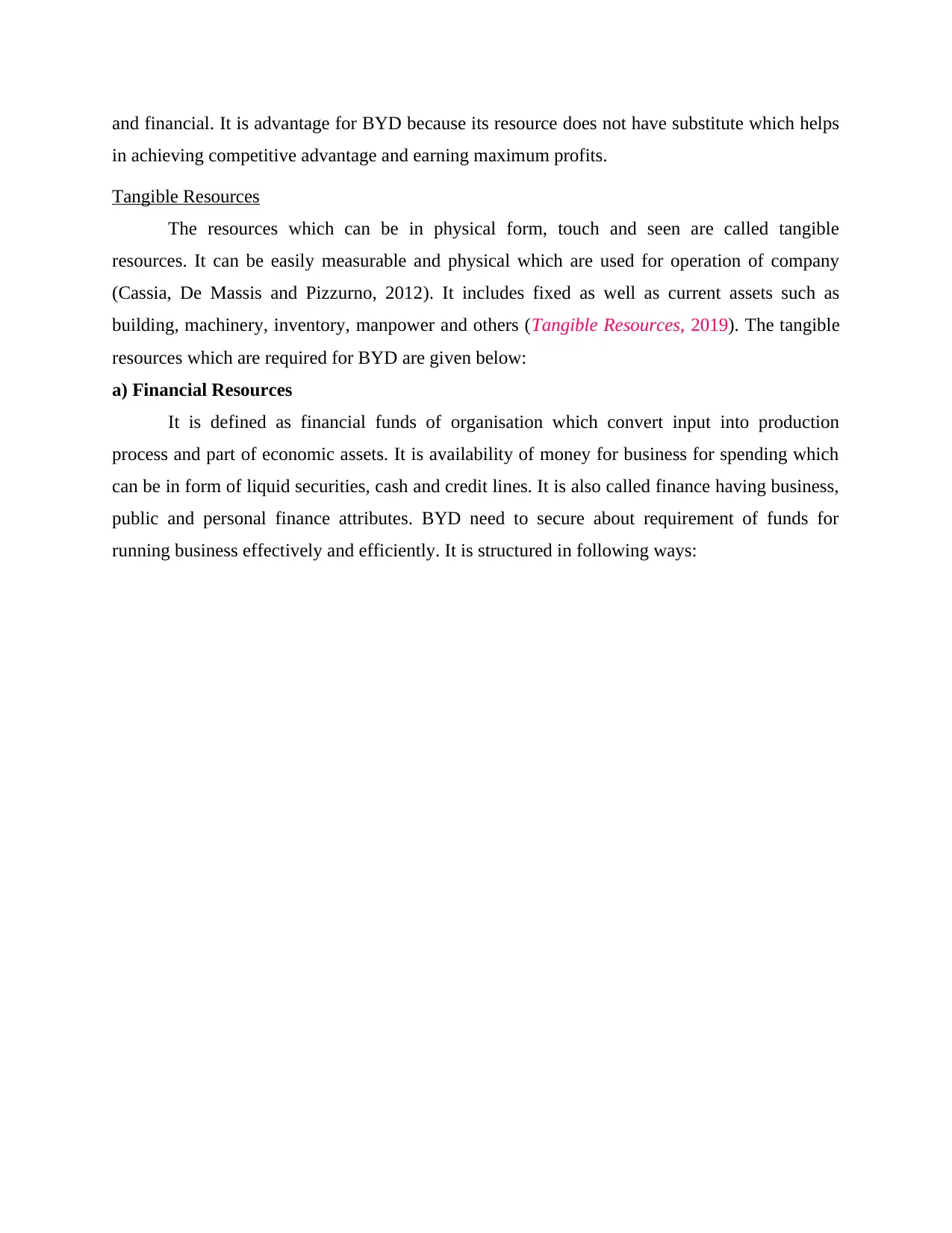
and financial. It is advantage for BYD because its resource does not have substitute which helps
in achieving competitive advantage and earning maximum profits.
Tangible Resources
The resources which can be in physical form, touch and seen are called tangible
resources. It can be easily measurable and physical which are used for operation of company
(Cassia, De Massis and Pizzurno, 2012). It includes fixed as well as current assets such as
building, machinery, inventory, manpower and others (Tangible Resources, 2019). The tangible
resources which are required for BYD are given below:
a) Financial Resources
It is defined as financial funds of organisation which convert input into production
process and part of economic assets. It is availability of money for business for spending which
can be in form of liquid securities, cash and credit lines. It is also called finance having business,
public and personal finance attributes. BYD need to secure about requirement of funds for
running business effectively and efficiently. It is structured in following ways:
in achieving competitive advantage and earning maximum profits.
Tangible Resources
The resources which can be in physical form, touch and seen are called tangible
resources. It can be easily measurable and physical which are used for operation of company
(Cassia, De Massis and Pizzurno, 2012). It includes fixed as well as current assets such as
building, machinery, inventory, manpower and others (Tangible Resources, 2019). The tangible
resources which are required for BYD are given below:
a) Financial Resources
It is defined as financial funds of organisation which convert input into production
process and part of economic assets. It is availability of money for business for spending which
can be in form of liquid securities, cash and credit lines. It is also called finance having business,
public and personal finance attributes. BYD need to secure about requirement of funds for
running business effectively and efficiently. It is structured in following ways:
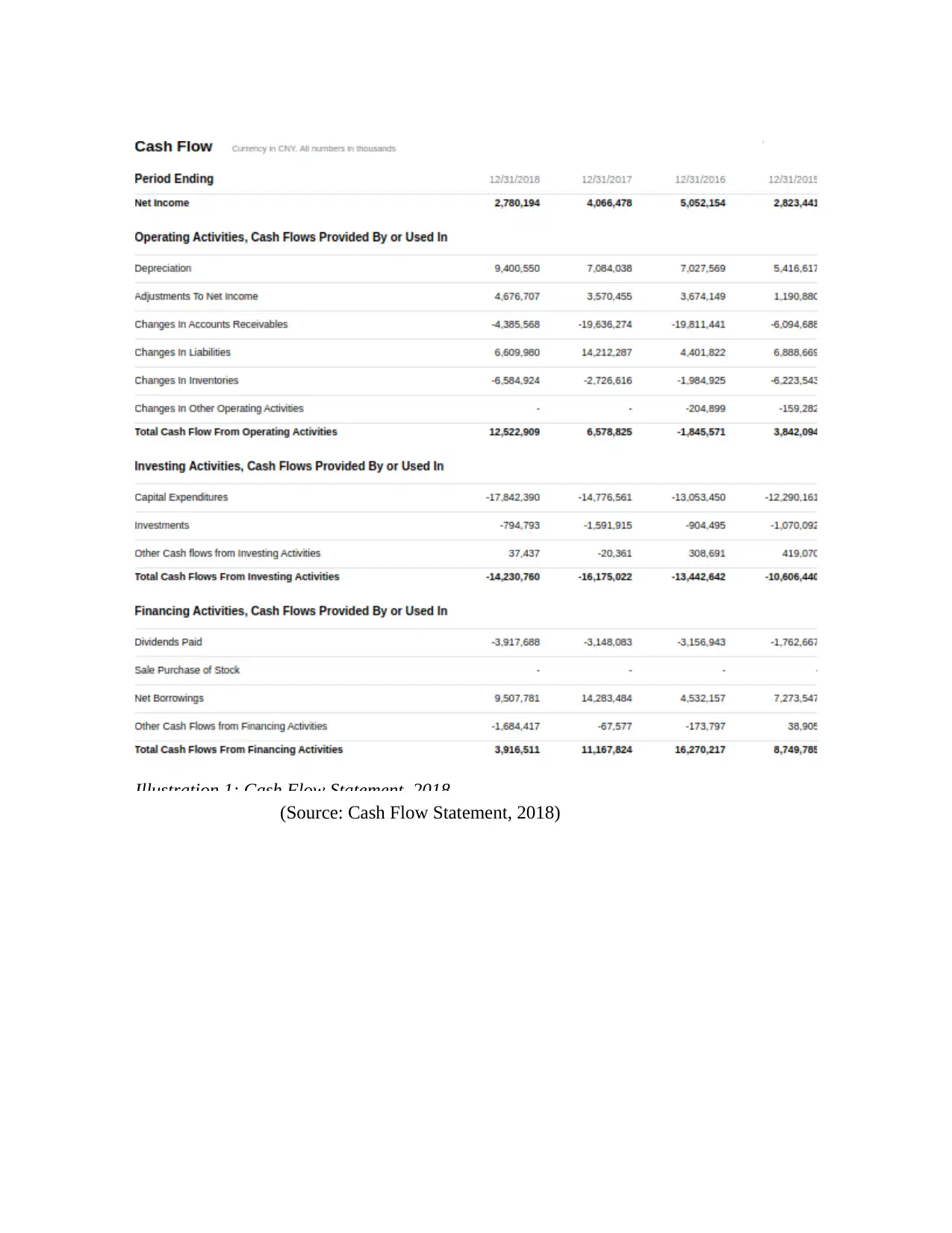
(Source: Cash Flow Statement, 2018)
Illustration 1: Cash Flow Statement, 2018
Illustration 1: Cash Flow Statement, 2018
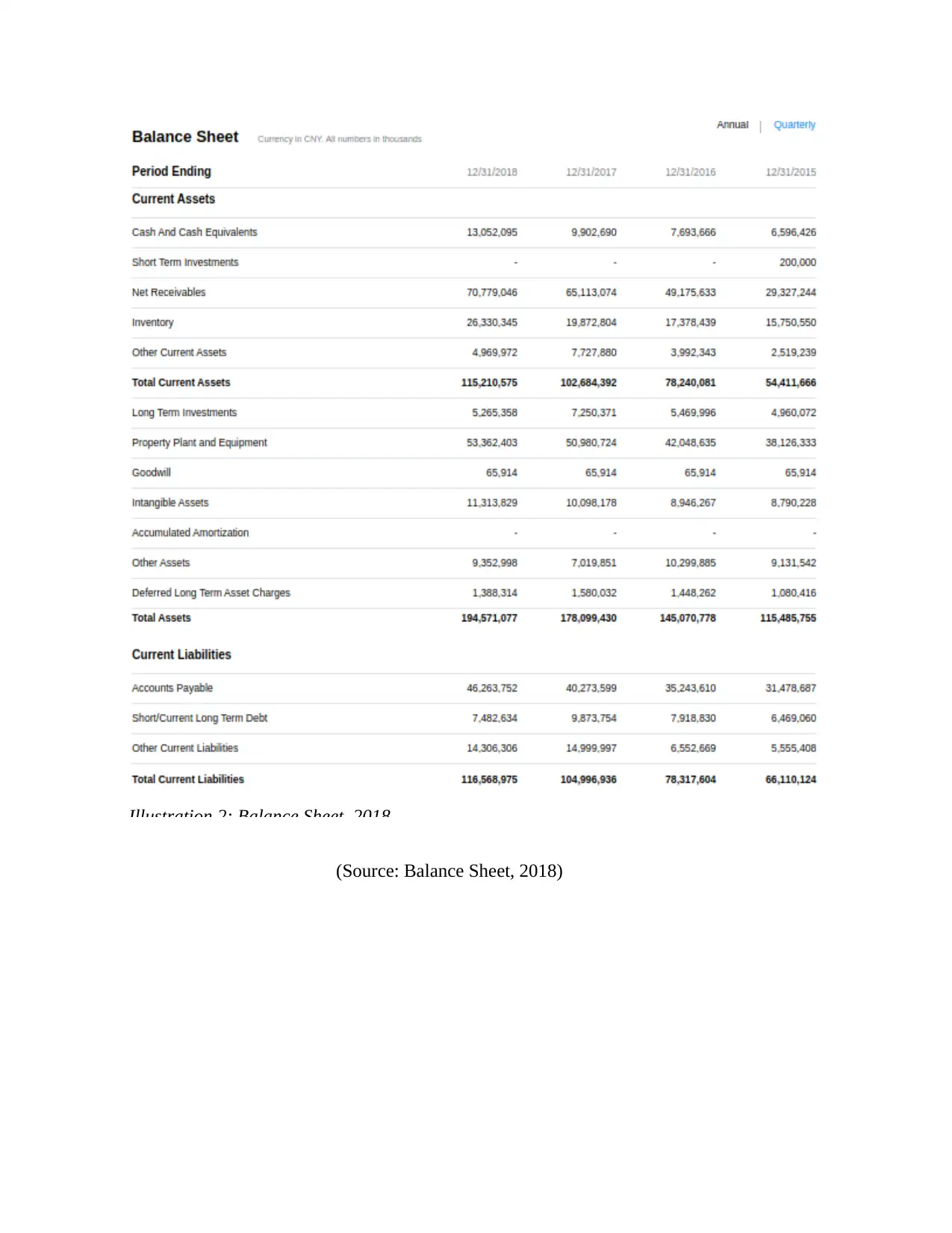
(Source: Balance Sheet, 2018)
Illustration 2: Balance Sheet, 2018
Illustration 2: Balance Sheet, 2018
Paraphrase This Document
Need a fresh take? Get an instant paraphrase of this document with our AI Paraphraser
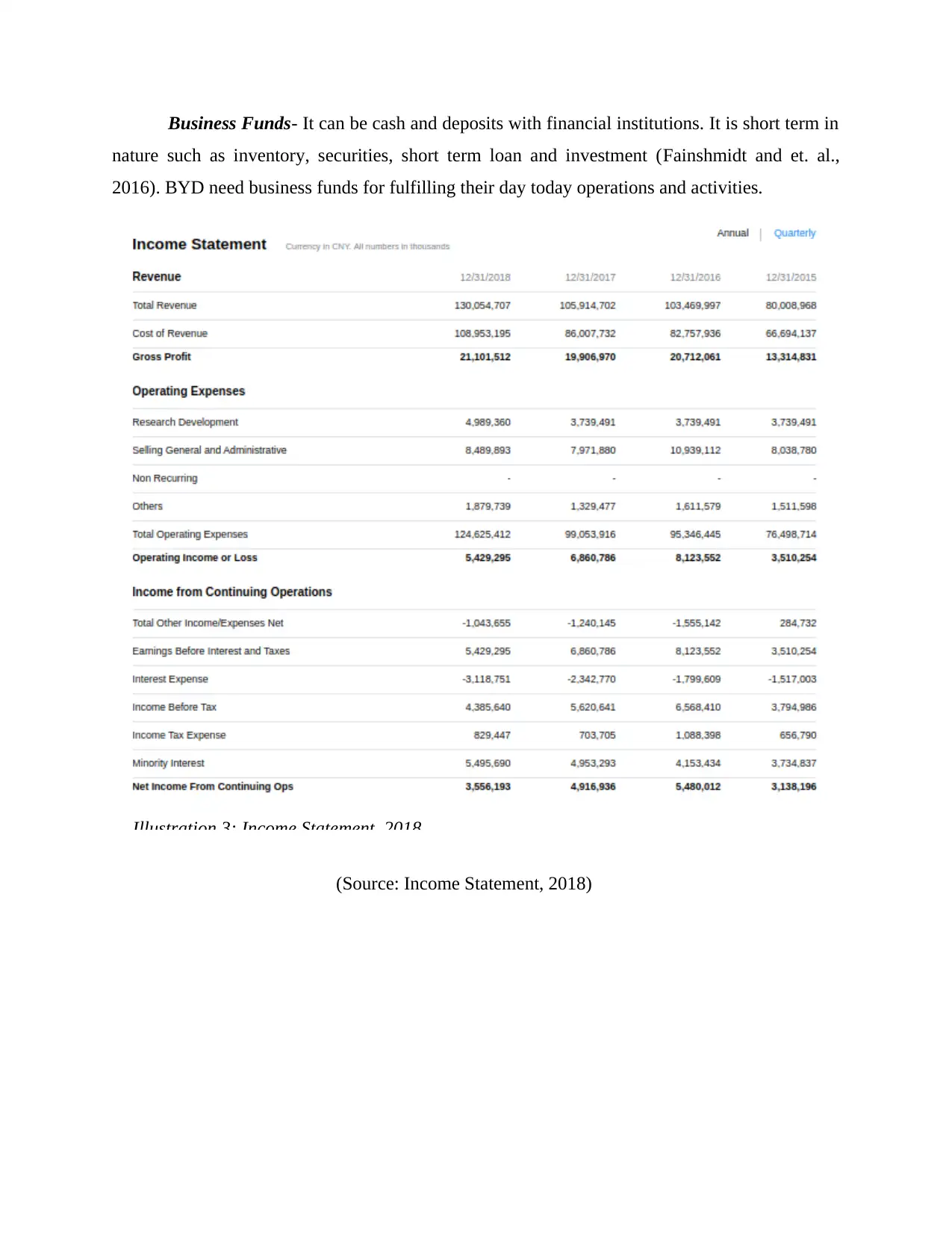
Business Funds- It can be cash and deposits with financial institutions. It is short term in
nature such as inventory, securities, short term loan and investment (Fainshmidt and et. al.,
2016). BYD need business funds for fulfilling their day today operations and activities.
(Source: Income Statement, 2018)
Illustration 3: Income Statement, 2018
nature such as inventory, securities, short term loan and investment (Fainshmidt and et. al.,
2016). BYD need business funds for fulfilling their day today operations and activities.
(Source: Income Statement, 2018)
Illustration 3: Income Statement, 2018
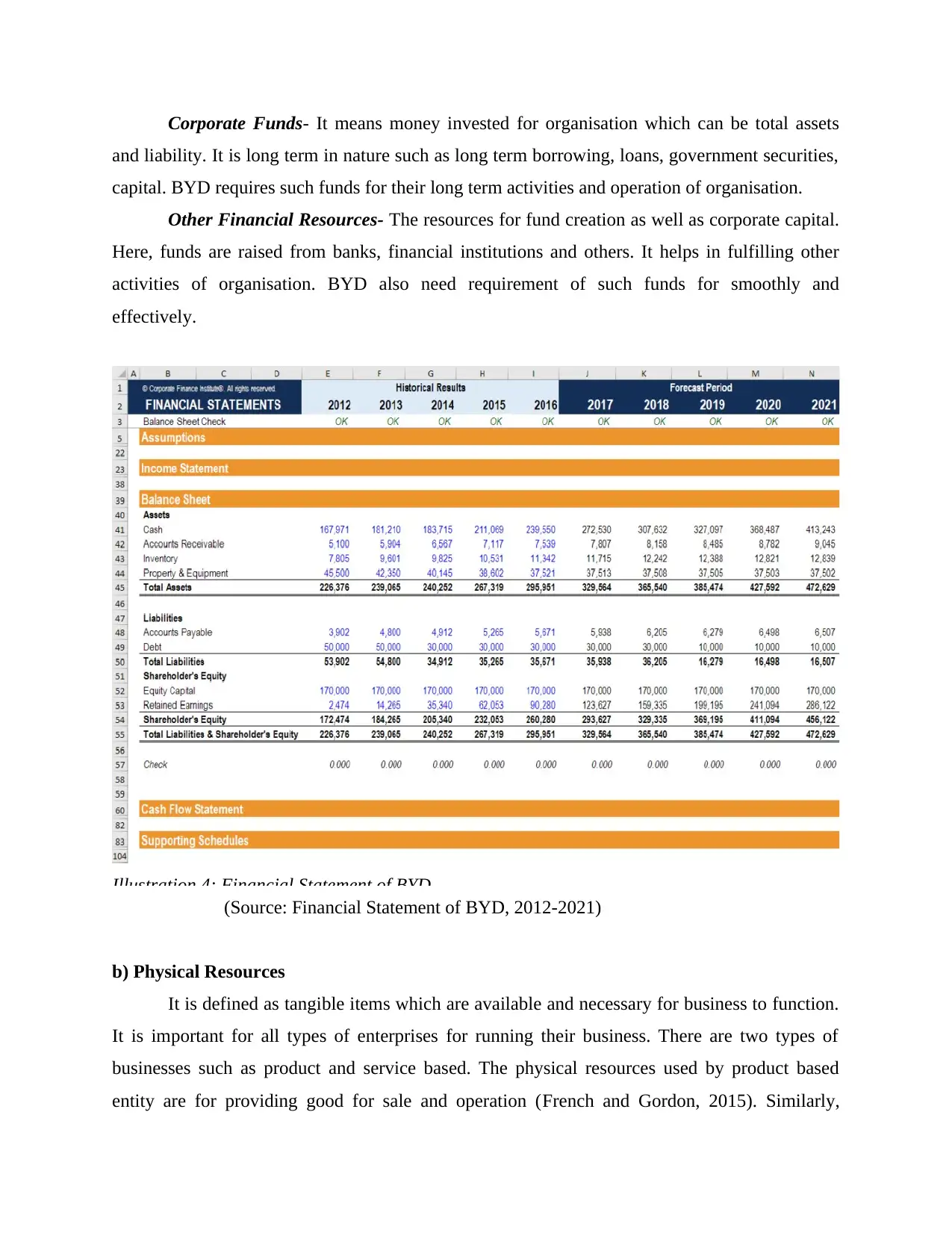
Corporate Funds- It means money invested for organisation which can be total assets
and liability. It is long term in nature such as long term borrowing, loans, government securities,
capital. BYD requires such funds for their long term activities and operation of organisation.
Other Financial Resources- The resources for fund creation as well as corporate capital.
Here, funds are raised from banks, financial institutions and others. It helps in fulfilling other
activities of organisation. BYD also need requirement of such funds for smoothly and
effectively.
(Source: Financial Statement of BYD, 2012-2021)
b) Physical Resources
It is defined as tangible items which are available and necessary for business to function.
It is important for all types of enterprises for running their business. There are two types of
businesses such as product and service based. The physical resources used by product based
entity are for providing good for sale and operation (French and Gordon, 2015). Similarly,
Illustration 4: Financial Statement of BYD
and liability. It is long term in nature such as long term borrowing, loans, government securities,
capital. BYD requires such funds for their long term activities and operation of organisation.
Other Financial Resources- The resources for fund creation as well as corporate capital.
Here, funds are raised from banks, financial institutions and others. It helps in fulfilling other
activities of organisation. BYD also need requirement of such funds for smoothly and
effectively.
(Source: Financial Statement of BYD, 2012-2021)
b) Physical Resources
It is defined as tangible items which are available and necessary for business to function.
It is important for all types of enterprises for running their business. There are two types of
businesses such as product and service based. The physical resources used by product based
entity are for providing good for sale and operation (French and Gordon, 2015). Similarly,
Illustration 4: Financial Statement of BYD
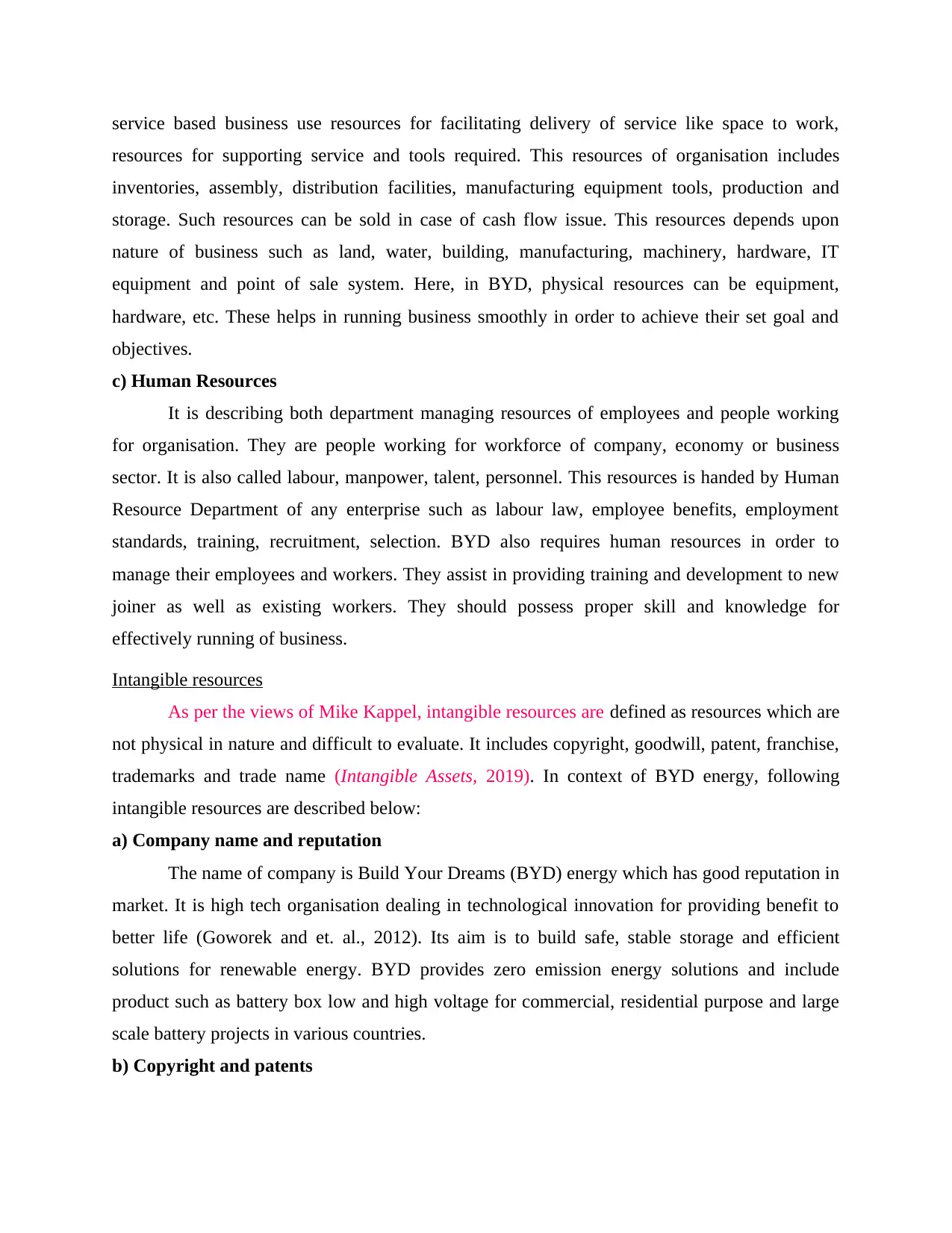
service based business use resources for facilitating delivery of service like space to work,
resources for supporting service and tools required. This resources of organisation includes
inventories, assembly, distribution facilities, manufacturing equipment tools, production and
storage. Such resources can be sold in case of cash flow issue. This resources depends upon
nature of business such as land, water, building, manufacturing, machinery, hardware, IT
equipment and point of sale system. Here, in BYD, physical resources can be equipment,
hardware, etc. These helps in running business smoothly in order to achieve their set goal and
objectives.
c) Human Resources
It is describing both department managing resources of employees and people working
for organisation. They are people working for workforce of company, economy or business
sector. It is also called labour, manpower, talent, personnel. This resources is handed by Human
Resource Department of any enterprise such as labour law, employee benefits, employment
standards, training, recruitment, selection. BYD also requires human resources in order to
manage their employees and workers. They assist in providing training and development to new
joiner as well as existing workers. They should possess proper skill and knowledge for
effectively running of business.
Intangible resources
As per the views of Mike Kappel, intangible resources are defined as resources which are
not physical in nature and difficult to evaluate. It includes copyright, goodwill, patent, franchise,
trademarks and trade name (Intangible Assets, 2019). In context of BYD energy, following
intangible resources are described below:
a) Company name and reputation
The name of company is Build Your Dreams (BYD) energy which has good reputation in
market. It is high tech organisation dealing in technological innovation for providing benefit to
better life (Goworek and et. al., 2012). Its aim is to build safe, stable storage and efficient
solutions for renewable energy. BYD provides zero emission energy solutions and include
product such as battery box low and high voltage for commercial, residential purpose and large
scale battery projects in various countries.
b) Copyright and patents
resources for supporting service and tools required. This resources of organisation includes
inventories, assembly, distribution facilities, manufacturing equipment tools, production and
storage. Such resources can be sold in case of cash flow issue. This resources depends upon
nature of business such as land, water, building, manufacturing, machinery, hardware, IT
equipment and point of sale system. Here, in BYD, physical resources can be equipment,
hardware, etc. These helps in running business smoothly in order to achieve their set goal and
objectives.
c) Human Resources
It is describing both department managing resources of employees and people working
for organisation. They are people working for workforce of company, economy or business
sector. It is also called labour, manpower, talent, personnel. This resources is handed by Human
Resource Department of any enterprise such as labour law, employee benefits, employment
standards, training, recruitment, selection. BYD also requires human resources in order to
manage their employees and workers. They assist in providing training and development to new
joiner as well as existing workers. They should possess proper skill and knowledge for
effectively running of business.
Intangible resources
As per the views of Mike Kappel, intangible resources are defined as resources which are
not physical in nature and difficult to evaluate. It includes copyright, goodwill, patent, franchise,
trademarks and trade name (Intangible Assets, 2019). In context of BYD energy, following
intangible resources are described below:
a) Company name and reputation
The name of company is Build Your Dreams (BYD) energy which has good reputation in
market. It is high tech organisation dealing in technological innovation for providing benefit to
better life (Goworek and et. al., 2012). Its aim is to build safe, stable storage and efficient
solutions for renewable energy. BYD provides zero emission energy solutions and include
product such as battery box low and high voltage for commercial, residential purpose and large
scale battery projects in various countries.
b) Copyright and patents
Secure Best Marks with AI Grader
Need help grading? Try our AI Grader for instant feedback on your assignments.
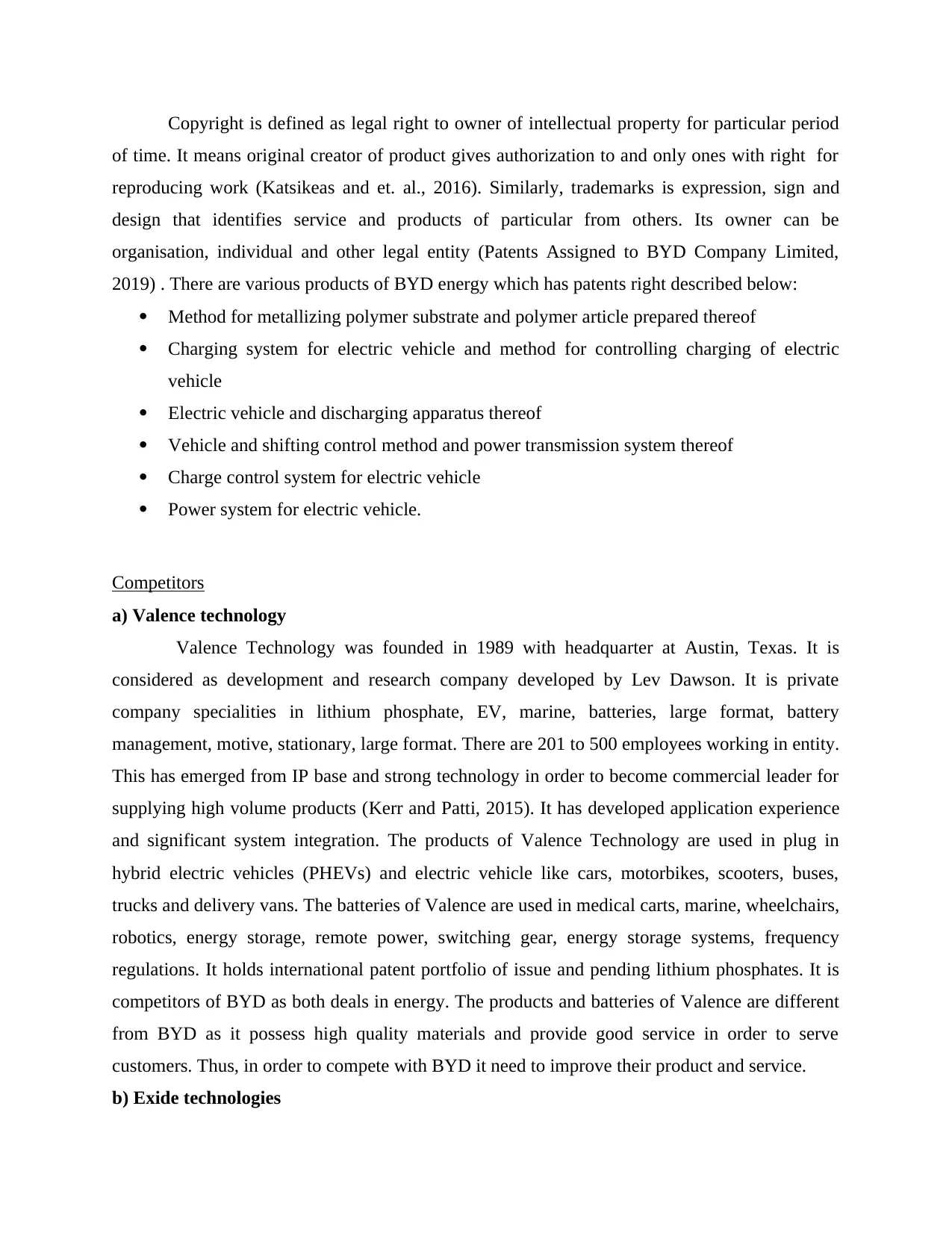
Copyright is defined as legal right to owner of intellectual property for particular period
of time. It means original creator of product gives authorization to and only ones with right for
reproducing work (Katsikeas and et. al., 2016). Similarly, trademarks is expression, sign and
design that identifies service and products of particular from others. Its owner can be
organisation, individual and other legal entity (Patents Assigned to BYD Company Limited,
2019) . There are various products of BYD energy which has patents right described below:
Method for metallizing polymer substrate and polymer article prepared thereof
Charging system for electric vehicle and method for controlling charging of electric
vehicle
Electric vehicle and discharging apparatus thereof
Vehicle and shifting control method and power transmission system thereof
Charge control system for electric vehicle
Power system for electric vehicle.
Competitors
a) Valence technology
Valence Technology was founded in 1989 with headquarter at Austin, Texas. It is
considered as development and research company developed by Lev Dawson. It is private
company specialities in lithium phosphate, EV, marine, batteries, large format, battery
management, motive, stationary, large format. There are 201 to 500 employees working in entity.
This has emerged from IP base and strong technology in order to become commercial leader for
supplying high volume products (Kerr and Patti, 2015). It has developed application experience
and significant system integration. The products of Valence Technology are used in plug in
hybrid electric vehicles (PHEVs) and electric vehicle like cars, motorbikes, scooters, buses,
trucks and delivery vans. The batteries of Valence are used in medical carts, marine, wheelchairs,
robotics, energy storage, remote power, switching gear, energy storage systems, frequency
regulations. It holds international patent portfolio of issue and pending lithium phosphates. It is
competitors of BYD as both deals in energy. The products and batteries of Valence are different
from BYD as it possess high quality materials and provide good service in order to serve
customers. Thus, in order to compete with BYD it need to improve their product and service.
b) Exide technologies
of time. It means original creator of product gives authorization to and only ones with right for
reproducing work (Katsikeas and et. al., 2016). Similarly, trademarks is expression, sign and
design that identifies service and products of particular from others. Its owner can be
organisation, individual and other legal entity (Patents Assigned to BYD Company Limited,
2019) . There are various products of BYD energy which has patents right described below:
Method for metallizing polymer substrate and polymer article prepared thereof
Charging system for electric vehicle and method for controlling charging of electric
vehicle
Electric vehicle and discharging apparatus thereof
Vehicle and shifting control method and power transmission system thereof
Charge control system for electric vehicle
Power system for electric vehicle.
Competitors
a) Valence technology
Valence Technology was founded in 1989 with headquarter at Austin, Texas. It is
considered as development and research company developed by Lev Dawson. It is private
company specialities in lithium phosphate, EV, marine, batteries, large format, battery
management, motive, stationary, large format. There are 201 to 500 employees working in entity.
This has emerged from IP base and strong technology in order to become commercial leader for
supplying high volume products (Kerr and Patti, 2015). It has developed application experience
and significant system integration. The products of Valence Technology are used in plug in
hybrid electric vehicles (PHEVs) and electric vehicle like cars, motorbikes, scooters, buses,
trucks and delivery vans. The batteries of Valence are used in medical carts, marine, wheelchairs,
robotics, energy storage, remote power, switching gear, energy storage systems, frequency
regulations. It holds international patent portfolio of issue and pending lithium phosphates. It is
competitors of BYD as both deals in energy. The products and batteries of Valence are different
from BYD as it possess high quality materials and provide good service in order to serve
customers. Thus, in order to compete with BYD it need to improve their product and service.
b) Exide technologies
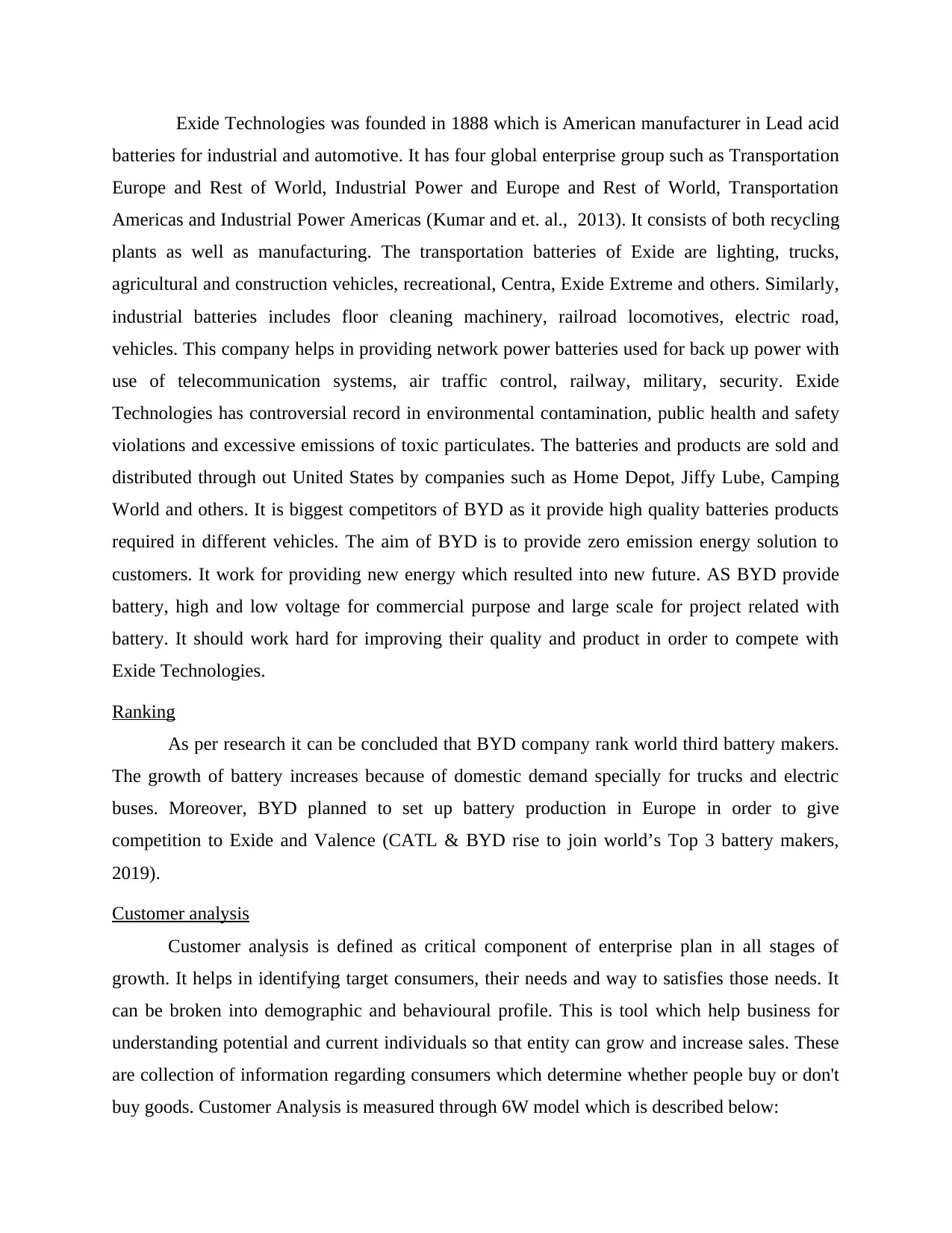
Exide Technologies was founded in 1888 which is American manufacturer in Lead acid
batteries for industrial and automotive. It has four global enterprise group such as Transportation
Europe and Rest of World, Industrial Power and Europe and Rest of World, Transportation
Americas and Industrial Power Americas (Kumar and et. al., 2013). It consists of both recycling
plants as well as manufacturing. The transportation batteries of Exide are lighting, trucks,
agricultural and construction vehicles, recreational, Centra, Exide Extreme and others. Similarly,
industrial batteries includes floor cleaning machinery, railroad locomotives, electric road,
vehicles. This company helps in providing network power batteries used for back up power with
use of telecommunication systems, air traffic control, railway, military, security. Exide
Technologies has controversial record in environmental contamination, public health and safety
violations and excessive emissions of toxic particulates. The batteries and products are sold and
distributed through out United States by companies such as Home Depot, Jiffy Lube, Camping
World and others. It is biggest competitors of BYD as it provide high quality batteries products
required in different vehicles. The aim of BYD is to provide zero emission energy solution to
customers. It work for providing new energy which resulted into new future. AS BYD provide
battery, high and low voltage for commercial purpose and large scale for project related with
battery. It should work hard for improving their quality and product in order to compete with
Exide Technologies.
Ranking
As per research it can be concluded that BYD company rank world third battery makers.
The growth of battery increases because of domestic demand specially for trucks and electric
buses. Moreover, BYD planned to set up battery production in Europe in order to give
competition to Exide and Valence (CATL & BYD rise to join world’s Top 3 battery makers,
2019).
Customer analysis
Customer analysis is defined as critical component of enterprise plan in all stages of
growth. It helps in identifying target consumers, their needs and way to satisfies those needs. It
can be broken into demographic and behavioural profile. This is tool which help business for
understanding potential and current individuals so that entity can grow and increase sales. These
are collection of information regarding consumers which determine whether people buy or don't
buy goods. Customer Analysis is measured through 6W model which is described below:
batteries for industrial and automotive. It has four global enterprise group such as Transportation
Europe and Rest of World, Industrial Power and Europe and Rest of World, Transportation
Americas and Industrial Power Americas (Kumar and et. al., 2013). It consists of both recycling
plants as well as manufacturing. The transportation batteries of Exide are lighting, trucks,
agricultural and construction vehicles, recreational, Centra, Exide Extreme and others. Similarly,
industrial batteries includes floor cleaning machinery, railroad locomotives, electric road,
vehicles. This company helps in providing network power batteries used for back up power with
use of telecommunication systems, air traffic control, railway, military, security. Exide
Technologies has controversial record in environmental contamination, public health and safety
violations and excessive emissions of toxic particulates. The batteries and products are sold and
distributed through out United States by companies such as Home Depot, Jiffy Lube, Camping
World and others. It is biggest competitors of BYD as it provide high quality batteries products
required in different vehicles. The aim of BYD is to provide zero emission energy solution to
customers. It work for providing new energy which resulted into new future. AS BYD provide
battery, high and low voltage for commercial purpose and large scale for project related with
battery. It should work hard for improving their quality and product in order to compete with
Exide Technologies.
Ranking
As per research it can be concluded that BYD company rank world third battery makers.
The growth of battery increases because of domestic demand specially for trucks and electric
buses. Moreover, BYD planned to set up battery production in Europe in order to give
competition to Exide and Valence (CATL & BYD rise to join world’s Top 3 battery makers,
2019).
Customer analysis
Customer analysis is defined as critical component of enterprise plan in all stages of
growth. It helps in identifying target consumers, their needs and way to satisfies those needs. It
can be broken into demographic and behavioural profile. This is tool which help business for
understanding potential and current individuals so that entity can grow and increase sales. These
are collection of information regarding consumers which determine whether people buy or don't
buy goods. Customer Analysis is measured through 6W model which is described below:
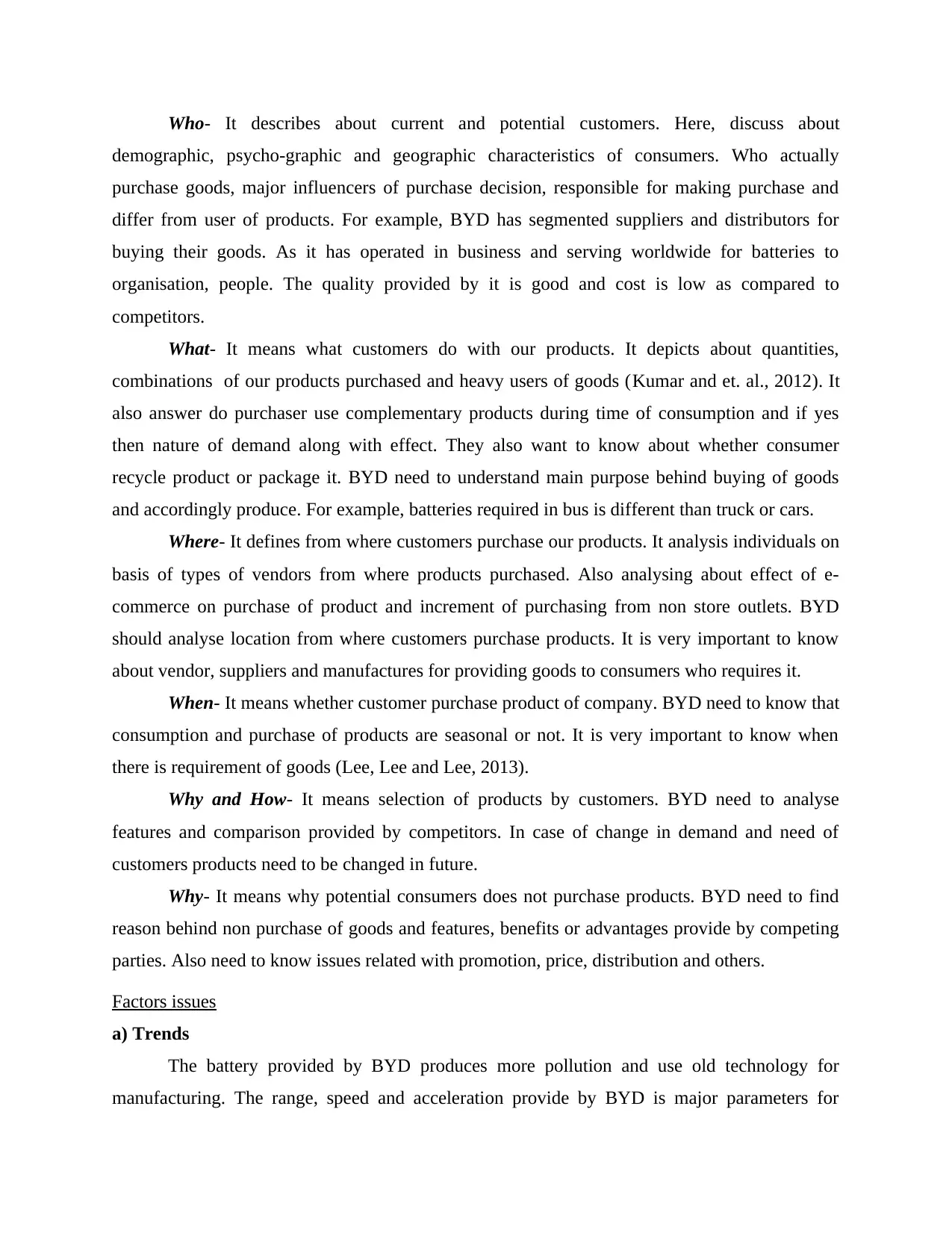
Who- It describes about current and potential customers. Here, discuss about
demographic, psycho-graphic and geographic characteristics of consumers. Who actually
purchase goods, major influencers of purchase decision, responsible for making purchase and
differ from user of products. For example, BYD has segmented suppliers and distributors for
buying their goods. As it has operated in business and serving worldwide for batteries to
organisation, people. The quality provided by it is good and cost is low as compared to
competitors.
What- It means what customers do with our products. It depicts about quantities,
combinations of our products purchased and heavy users of goods (Kumar and et. al., 2012). It
also answer do purchaser use complementary products during time of consumption and if yes
then nature of demand along with effect. They also want to know about whether consumer
recycle product or package it. BYD need to understand main purpose behind buying of goods
and accordingly produce. For example, batteries required in bus is different than truck or cars.
Where- It defines from where customers purchase our products. It analysis individuals on
basis of types of vendors from where products purchased. Also analysing about effect of e-
commerce on purchase of product and increment of purchasing from non store outlets. BYD
should analyse location from where customers purchase products. It is very important to know
about vendor, suppliers and manufactures for providing goods to consumers who requires it.
When- It means whether customer purchase product of company. BYD need to know that
consumption and purchase of products are seasonal or not. It is very important to know when
there is requirement of goods (Lee, Lee and Lee, 2013).
Why and How- It means selection of products by customers. BYD need to analyse
features and comparison provided by competitors. In case of change in demand and need of
customers products need to be changed in future.
Why- It means why potential consumers does not purchase products. BYD need to find
reason behind non purchase of goods and features, benefits or advantages provide by competing
parties. Also need to know issues related with promotion, price, distribution and others.
Factors issues
a) Trends
The battery provided by BYD produces more pollution and use old technology for
manufacturing. The range, speed and acceleration provide by BYD is major parameters for
demographic, psycho-graphic and geographic characteristics of consumers. Who actually
purchase goods, major influencers of purchase decision, responsible for making purchase and
differ from user of products. For example, BYD has segmented suppliers and distributors for
buying their goods. As it has operated in business and serving worldwide for batteries to
organisation, people. The quality provided by it is good and cost is low as compared to
competitors.
What- It means what customers do with our products. It depicts about quantities,
combinations of our products purchased and heavy users of goods (Kumar and et. al., 2012). It
also answer do purchaser use complementary products during time of consumption and if yes
then nature of demand along with effect. They also want to know about whether consumer
recycle product or package it. BYD need to understand main purpose behind buying of goods
and accordingly produce. For example, batteries required in bus is different than truck or cars.
Where- It defines from where customers purchase our products. It analysis individuals on
basis of types of vendors from where products purchased. Also analysing about effect of e-
commerce on purchase of product and increment of purchasing from non store outlets. BYD
should analyse location from where customers purchase products. It is very important to know
about vendor, suppliers and manufactures for providing goods to consumers who requires it.
When- It means whether customer purchase product of company. BYD need to know that
consumption and purchase of products are seasonal or not. It is very important to know when
there is requirement of goods (Lee, Lee and Lee, 2013).
Why and How- It means selection of products by customers. BYD need to analyse
features and comparison provided by competitors. In case of change in demand and need of
customers products need to be changed in future.
Why- It means why potential consumers does not purchase products. BYD need to find
reason behind non purchase of goods and features, benefits or advantages provide by competing
parties. Also need to know issues related with promotion, price, distribution and others.
Factors issues
a) Trends
The battery provided by BYD produces more pollution and use old technology for
manufacturing. The range, speed and acceleration provide by BYD is major parameters for
Paraphrase This Document
Need a fresh take? Get an instant paraphrase of this document with our AI Paraphraser
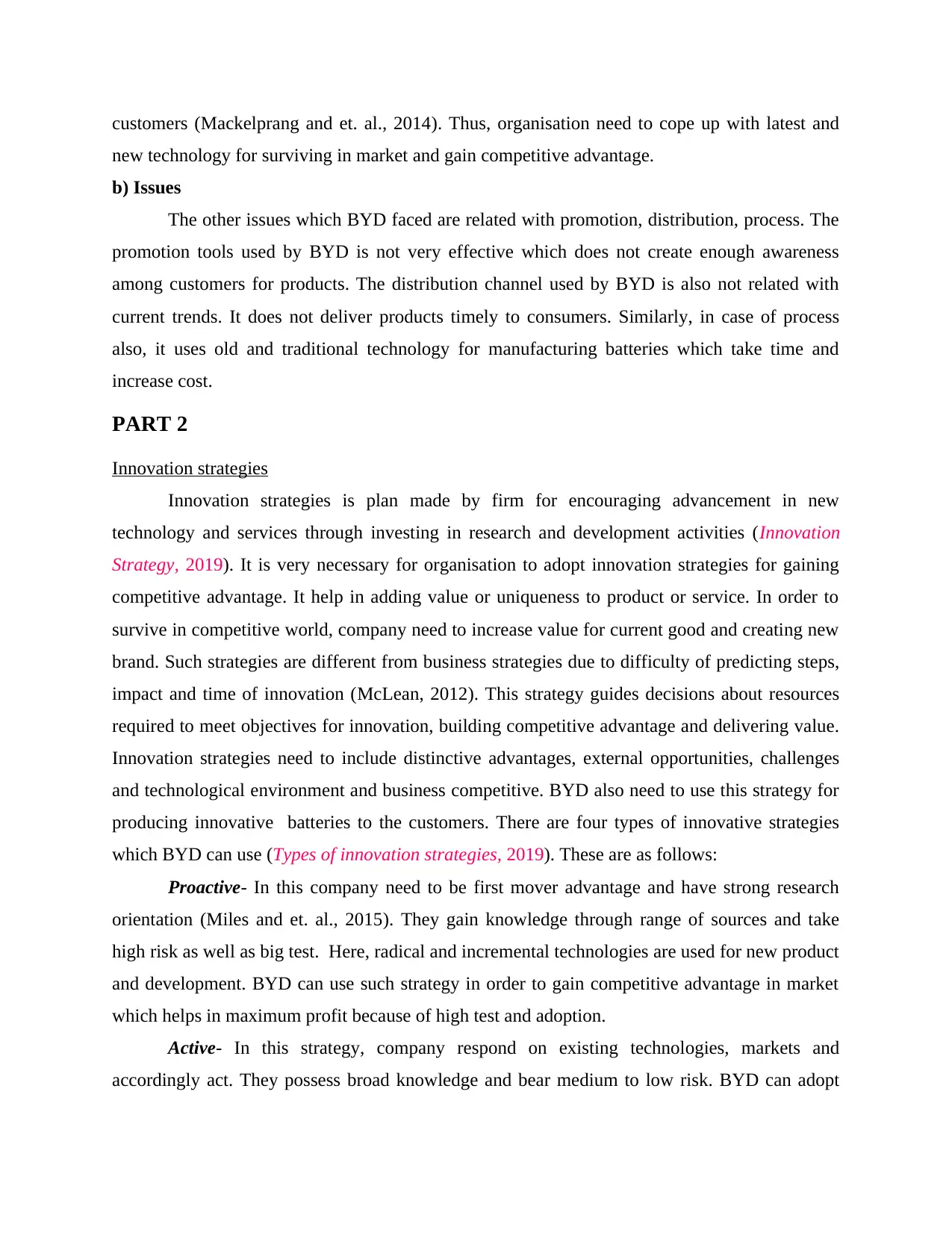
customers (Mackelprang and et. al., 2014). Thus, organisation need to cope up with latest and
new technology for surviving in market and gain competitive advantage.
b) Issues
The other issues which BYD faced are related with promotion, distribution, process. The
promotion tools used by BYD is not very effective which does not create enough awareness
among customers for products. The distribution channel used by BYD is also not related with
current trends. It does not deliver products timely to consumers. Similarly, in case of process
also, it uses old and traditional technology for manufacturing batteries which take time and
increase cost.
PART 2
Innovation strategies
Innovation strategies is plan made by firm for encouraging advancement in new
technology and services through investing in research and development activities (Innovation
Strategy, 2019). It is very necessary for organisation to adopt innovation strategies for gaining
competitive advantage. It help in adding value or uniqueness to product or service. In order to
survive in competitive world, company need to increase value for current good and creating new
brand. Such strategies are different from business strategies due to difficulty of predicting steps,
impact and time of innovation (McLean, 2012). This strategy guides decisions about resources
required to meet objectives for innovation, building competitive advantage and delivering value.
Innovation strategies need to include distinctive advantages, external opportunities, challenges
and technological environment and business competitive. BYD also need to use this strategy for
producing innovative batteries to the customers. There are four types of innovative strategies
which BYD can use (Types of innovation strategies, 2019). These are as follows:
Proactive- In this company need to be first mover advantage and have strong research
orientation (Miles and et. al., 2015). They gain knowledge through range of sources and take
high risk as well as big test. Here, radical and incremental technologies are used for new product
and development. BYD can use such strategy in order to gain competitive advantage in market
which helps in maximum profit because of high test and adoption.
Active- In this strategy, company respond on existing technologies, markets and
accordingly act. They possess broad knowledge and bear medium to low risk. BYD can adopt
new technology for surviving in market and gain competitive advantage.
b) Issues
The other issues which BYD faced are related with promotion, distribution, process. The
promotion tools used by BYD is not very effective which does not create enough awareness
among customers for products. The distribution channel used by BYD is also not related with
current trends. It does not deliver products timely to consumers. Similarly, in case of process
also, it uses old and traditional technology for manufacturing batteries which take time and
increase cost.
PART 2
Innovation strategies
Innovation strategies is plan made by firm for encouraging advancement in new
technology and services through investing in research and development activities (Innovation
Strategy, 2019). It is very necessary for organisation to adopt innovation strategies for gaining
competitive advantage. It help in adding value or uniqueness to product or service. In order to
survive in competitive world, company need to increase value for current good and creating new
brand. Such strategies are different from business strategies due to difficulty of predicting steps,
impact and time of innovation (McLean, 2012). This strategy guides decisions about resources
required to meet objectives for innovation, building competitive advantage and delivering value.
Innovation strategies need to include distinctive advantages, external opportunities, challenges
and technological environment and business competitive. BYD also need to use this strategy for
producing innovative batteries to the customers. There are four types of innovative strategies
which BYD can use (Types of innovation strategies, 2019). These are as follows:
Proactive- In this company need to be first mover advantage and have strong research
orientation (Miles and et. al., 2015). They gain knowledge through range of sources and take
high risk as well as big test. Here, radical and incremental technologies are used for new product
and development. BYD can use such strategy in order to gain competitive advantage in market
which helps in maximum profit because of high test and adoption.
Active- In this strategy, company respond on existing technologies, markets and
accordingly act. They possess broad knowledge and bear medium to low risk. BYD can adopt
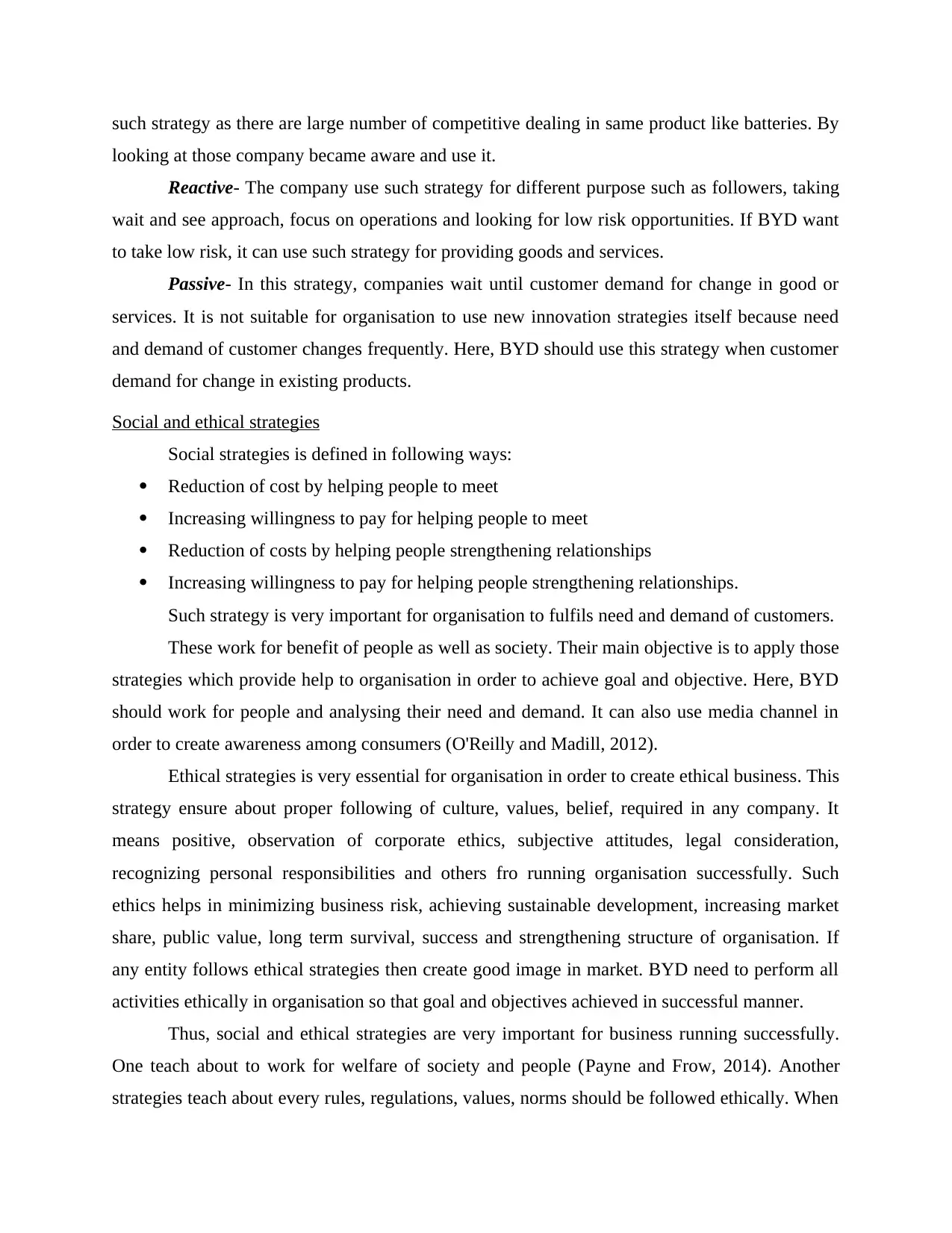
such strategy as there are large number of competitive dealing in same product like batteries. By
looking at those company became aware and use it.
Reactive- The company use such strategy for different purpose such as followers, taking
wait and see approach, focus on operations and looking for low risk opportunities. If BYD want
to take low risk, it can use such strategy for providing goods and services.
Passive- In this strategy, companies wait until customer demand for change in good or
services. It is not suitable for organisation to use new innovation strategies itself because need
and demand of customer changes frequently. Here, BYD should use this strategy when customer
demand for change in existing products.
Social and ethical strategies
Social strategies is defined in following ways:
Reduction of cost by helping people to meet
Increasing willingness to pay for helping people to meet
Reduction of costs by helping people strengthening relationships
Increasing willingness to pay for helping people strengthening relationships.
Such strategy is very important for organisation to fulfils need and demand of customers.
These work for benefit of people as well as society. Their main objective is to apply those
strategies which provide help to organisation in order to achieve goal and objective. Here, BYD
should work for people and analysing their need and demand. It can also use media channel in
order to create awareness among consumers (O'Reilly and Madill, 2012).
Ethical strategies is very essential for organisation in order to create ethical business. This
strategy ensure about proper following of culture, values, belief, required in any company. It
means positive, observation of corporate ethics, subjective attitudes, legal consideration,
recognizing personal responsibilities and others fro running organisation successfully. Such
ethics helps in minimizing business risk, achieving sustainable development, increasing market
share, public value, long term survival, success and strengthening structure of organisation. If
any entity follows ethical strategies then create good image in market. BYD need to perform all
activities ethically in organisation so that goal and objectives achieved in successful manner.
Thus, social and ethical strategies are very important for business running successfully.
One teach about to work for welfare of society and people (Payne and Frow, 2014). Another
strategies teach about every rules, regulations, values, norms should be followed ethically. When
looking at those company became aware and use it.
Reactive- The company use such strategy for different purpose such as followers, taking
wait and see approach, focus on operations and looking for low risk opportunities. If BYD want
to take low risk, it can use such strategy for providing goods and services.
Passive- In this strategy, companies wait until customer demand for change in good or
services. It is not suitable for organisation to use new innovation strategies itself because need
and demand of customer changes frequently. Here, BYD should use this strategy when customer
demand for change in existing products.
Social and ethical strategies
Social strategies is defined in following ways:
Reduction of cost by helping people to meet
Increasing willingness to pay for helping people to meet
Reduction of costs by helping people strengthening relationships
Increasing willingness to pay for helping people strengthening relationships.
Such strategy is very important for organisation to fulfils need and demand of customers.
These work for benefit of people as well as society. Their main objective is to apply those
strategies which provide help to organisation in order to achieve goal and objective. Here, BYD
should work for people and analysing their need and demand. It can also use media channel in
order to create awareness among consumers (O'Reilly and Madill, 2012).
Ethical strategies is very essential for organisation in order to create ethical business. This
strategy ensure about proper following of culture, values, belief, required in any company. It
means positive, observation of corporate ethics, subjective attitudes, legal consideration,
recognizing personal responsibilities and others fro running organisation successfully. Such
ethics helps in minimizing business risk, achieving sustainable development, increasing market
share, public value, long term survival, success and strengthening structure of organisation. If
any entity follows ethical strategies then create good image in market. BYD need to perform all
activities ethically in organisation so that goal and objectives achieved in successful manner.
Thus, social and ethical strategies are very important for business running successfully.
One teach about to work for welfare of society and people (Payne and Frow, 2014). Another
strategies teach about every rules, regulations, values, norms should be followed ethically. When
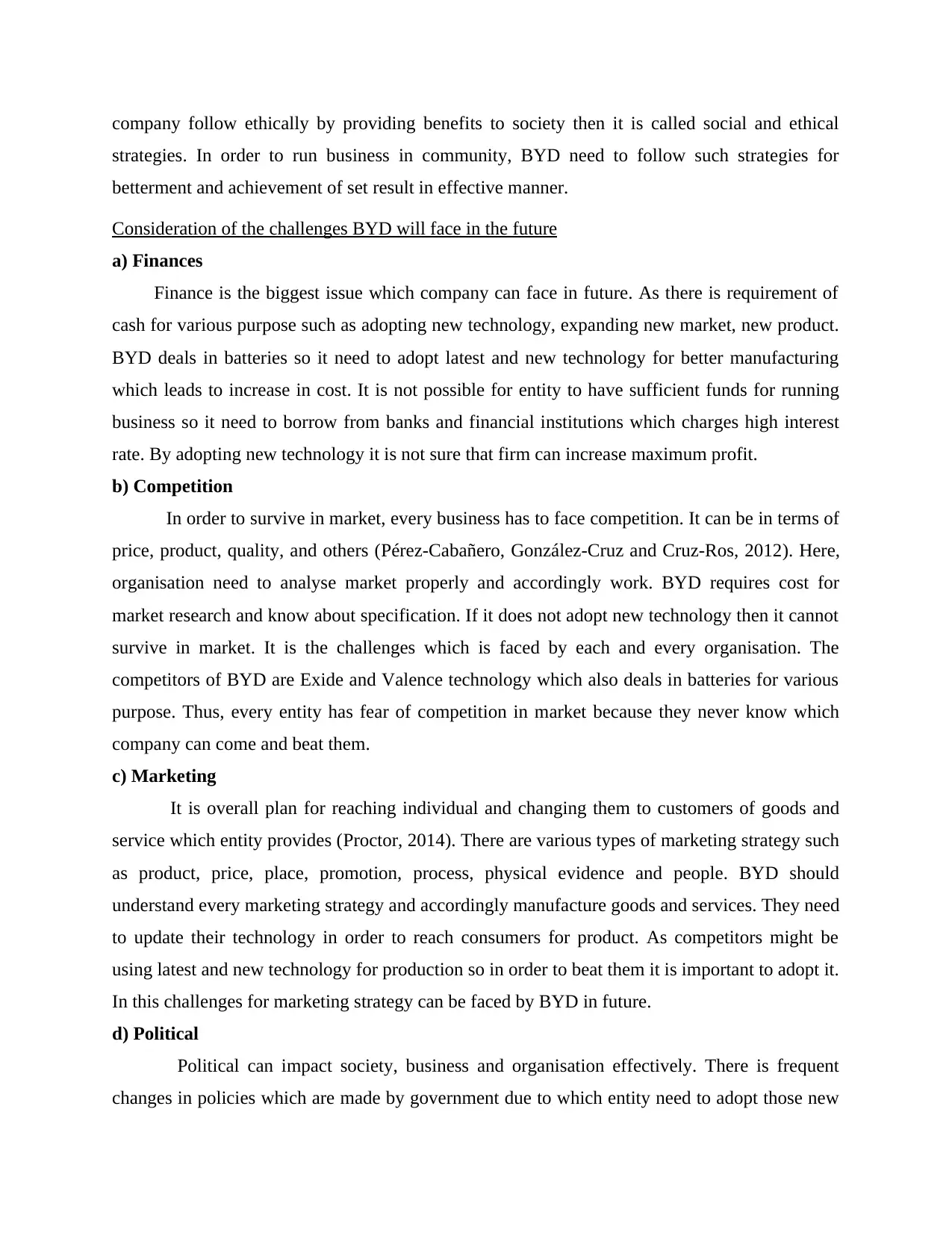
company follow ethically by providing benefits to society then it is called social and ethical
strategies. In order to run business in community, BYD need to follow such strategies for
betterment and achievement of set result in effective manner.
Consideration of the challenges BYD will face in the future
a) Finances
Finance is the biggest issue which company can face in future. As there is requirement of
cash for various purpose such as adopting new technology, expanding new market, new product.
BYD deals in batteries so it need to adopt latest and new technology for better manufacturing
which leads to increase in cost. It is not possible for entity to have sufficient funds for running
business so it need to borrow from banks and financial institutions which charges high interest
rate. By adopting new technology it is not sure that firm can increase maximum profit.
b) Competition
In order to survive in market, every business has to face competition. It can be in terms of
price, product, quality, and others (Pérez-Cabañero, González-Cruz and Cruz-Ros, 2012). Here,
organisation need to analyse market properly and accordingly work. BYD requires cost for
market research and know about specification. If it does not adopt new technology then it cannot
survive in market. It is the challenges which is faced by each and every organisation. The
competitors of BYD are Exide and Valence technology which also deals in batteries for various
purpose. Thus, every entity has fear of competition in market because they never know which
company can come and beat them.
c) Marketing
It is overall plan for reaching individual and changing them to customers of goods and
service which entity provides (Proctor, 2014). There are various types of marketing strategy such
as product, price, place, promotion, process, physical evidence and people. BYD should
understand every marketing strategy and accordingly manufacture goods and services. They need
to update their technology in order to reach consumers for product. As competitors might be
using latest and new technology for production so in order to beat them it is important to adopt it.
In this challenges for marketing strategy can be faced by BYD in future.
d) Political
Political can impact society, business and organisation effectively. There is frequent
changes in policies which are made by government due to which entity need to adopt those new
strategies. In order to run business in community, BYD need to follow such strategies for
betterment and achievement of set result in effective manner.
Consideration of the challenges BYD will face in the future
a) Finances
Finance is the biggest issue which company can face in future. As there is requirement of
cash for various purpose such as adopting new technology, expanding new market, new product.
BYD deals in batteries so it need to adopt latest and new technology for better manufacturing
which leads to increase in cost. It is not possible for entity to have sufficient funds for running
business so it need to borrow from banks and financial institutions which charges high interest
rate. By adopting new technology it is not sure that firm can increase maximum profit.
b) Competition
In order to survive in market, every business has to face competition. It can be in terms of
price, product, quality, and others (Pérez-Cabañero, González-Cruz and Cruz-Ros, 2012). Here,
organisation need to analyse market properly and accordingly work. BYD requires cost for
market research and know about specification. If it does not adopt new technology then it cannot
survive in market. It is the challenges which is faced by each and every organisation. The
competitors of BYD are Exide and Valence technology which also deals in batteries for various
purpose. Thus, every entity has fear of competition in market because they never know which
company can come and beat them.
c) Marketing
It is overall plan for reaching individual and changing them to customers of goods and
service which entity provides (Proctor, 2014). There are various types of marketing strategy such
as product, price, place, promotion, process, physical evidence and people. BYD should
understand every marketing strategy and accordingly manufacture goods and services. They need
to update their technology in order to reach consumers for product. As competitors might be
using latest and new technology for production so in order to beat them it is important to adopt it.
In this challenges for marketing strategy can be faced by BYD in future.
d) Political
Political can impact society, business and organisation effectively. There is frequent
changes in policies which are made by government due to which entity need to adopt those new
Secure Best Marks with AI Grader
Need help grading? Try our AI Grader for instant feedback on your assignments.
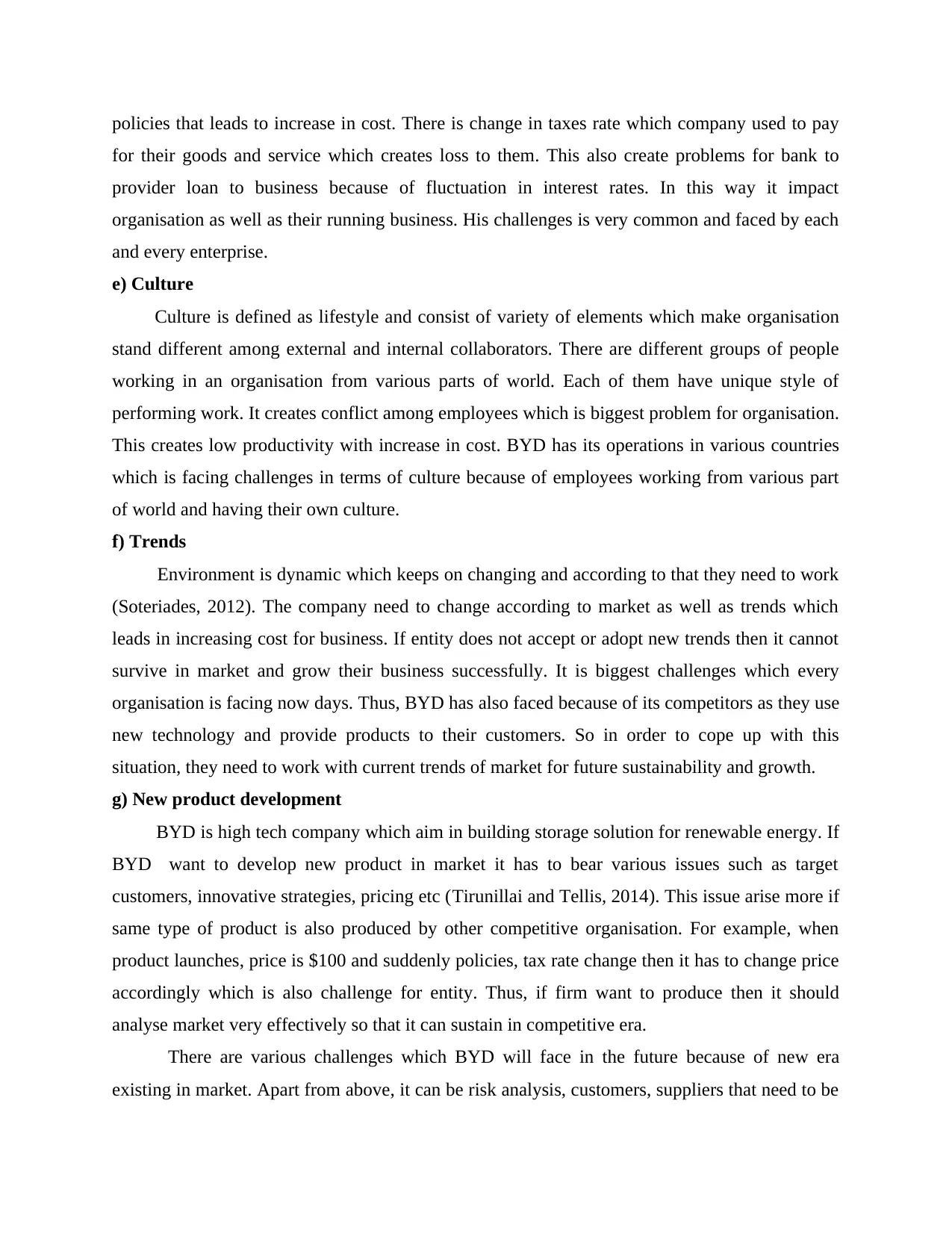
policies that leads to increase in cost. There is change in taxes rate which company used to pay
for their goods and service which creates loss to them. This also create problems for bank to
provider loan to business because of fluctuation in interest rates. In this way it impact
organisation as well as their running business. His challenges is very common and faced by each
and every enterprise.
e) Culture
Culture is defined as lifestyle and consist of variety of elements which make organisation
stand different among external and internal collaborators. There are different groups of people
working in an organisation from various parts of world. Each of them have unique style of
performing work. It creates conflict among employees which is biggest problem for organisation.
This creates low productivity with increase in cost. BYD has its operations in various countries
which is facing challenges in terms of culture because of employees working from various part
of world and having their own culture.
f) Trends
Environment is dynamic which keeps on changing and according to that they need to work
(Soteriades, 2012). The company need to change according to market as well as trends which
leads in increasing cost for business. If entity does not accept or adopt new trends then it cannot
survive in market and grow their business successfully. It is biggest challenges which every
organisation is facing now days. Thus, BYD has also faced because of its competitors as they use
new technology and provide products to their customers. So in order to cope up with this
situation, they need to work with current trends of market for future sustainability and growth.
g) New product development
BYD is high tech company which aim in building storage solution for renewable energy. If
BYD want to develop new product in market it has to bear various issues such as target
customers, innovative strategies, pricing etc (Tirunillai and Tellis, 2014). This issue arise more if
same type of product is also produced by other competitive organisation. For example, when
product launches, price is $100 and suddenly policies, tax rate change then it has to change price
accordingly which is also challenge for entity. Thus, if firm want to produce then it should
analyse market very effectively so that it can sustain in competitive era.
There are various challenges which BYD will face in the future because of new era
existing in market. Apart from above, it can be risk analysis, customers, suppliers that need to be
for their goods and service which creates loss to them. This also create problems for bank to
provider loan to business because of fluctuation in interest rates. In this way it impact
organisation as well as their running business. His challenges is very common and faced by each
and every enterprise.
e) Culture
Culture is defined as lifestyle and consist of variety of elements which make organisation
stand different among external and internal collaborators. There are different groups of people
working in an organisation from various parts of world. Each of them have unique style of
performing work. It creates conflict among employees which is biggest problem for organisation.
This creates low productivity with increase in cost. BYD has its operations in various countries
which is facing challenges in terms of culture because of employees working from various part
of world and having their own culture.
f) Trends
Environment is dynamic which keeps on changing and according to that they need to work
(Soteriades, 2012). The company need to change according to market as well as trends which
leads in increasing cost for business. If entity does not accept or adopt new trends then it cannot
survive in market and grow their business successfully. It is biggest challenges which every
organisation is facing now days. Thus, BYD has also faced because of its competitors as they use
new technology and provide products to their customers. So in order to cope up with this
situation, they need to work with current trends of market for future sustainability and growth.
g) New product development
BYD is high tech company which aim in building storage solution for renewable energy. If
BYD want to develop new product in market it has to bear various issues such as target
customers, innovative strategies, pricing etc (Tirunillai and Tellis, 2014). This issue arise more if
same type of product is also produced by other competitive organisation. For example, when
product launches, price is $100 and suddenly policies, tax rate change then it has to change price
accordingly which is also challenge for entity. Thus, if firm want to produce then it should
analyse market very effectively so that it can sustain in competitive era.
There are various challenges which BYD will face in the future because of new era
existing in market. Apart from above, it can be risk analysis, customers, suppliers that need to be
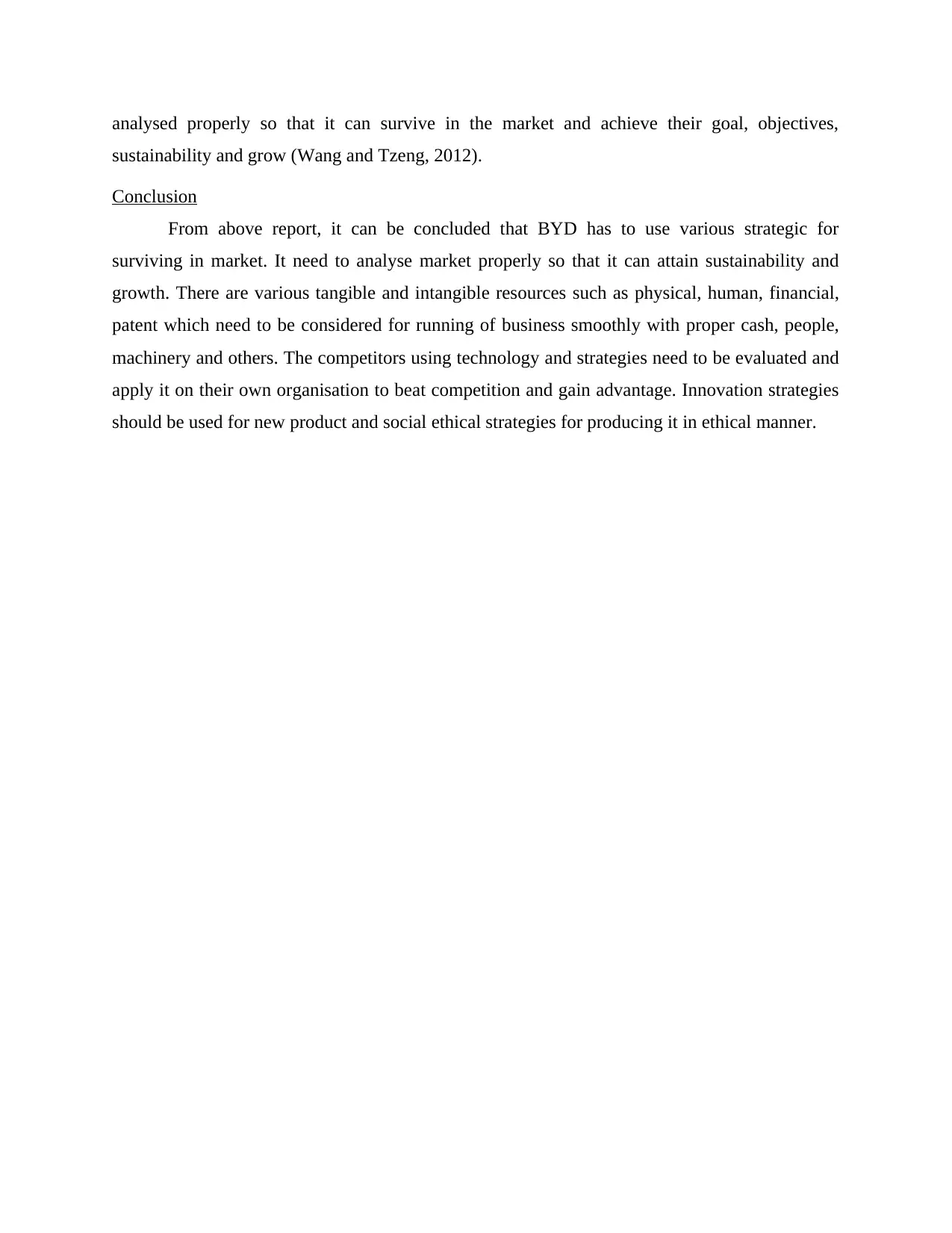
analysed properly so that it can survive in the market and achieve their goal, objectives,
sustainability and grow (Wang and Tzeng, 2012).
Conclusion
From above report, it can be concluded that BYD has to use various strategic for
surviving in market. It need to analyse market properly so that it can attain sustainability and
growth. There are various tangible and intangible resources such as physical, human, financial,
patent which need to be considered for running of business smoothly with proper cash, people,
machinery and others. The competitors using technology and strategies need to be evaluated and
apply it on their own organisation to beat competition and gain advantage. Innovation strategies
should be used for new product and social ethical strategies for producing it in ethical manner.
sustainability and grow (Wang and Tzeng, 2012).
Conclusion
From above report, it can be concluded that BYD has to use various strategic for
surviving in market. It need to analyse market properly so that it can attain sustainability and
growth. There are various tangible and intangible resources such as physical, human, financial,
patent which need to be considered for running of business smoothly with proper cash, people,
machinery and others. The competitors using technology and strategies need to be evaluated and
apply it on their own organisation to beat competition and gain advantage. Innovation strategies
should be used for new product and social ethical strategies for producing it in ethical manner.
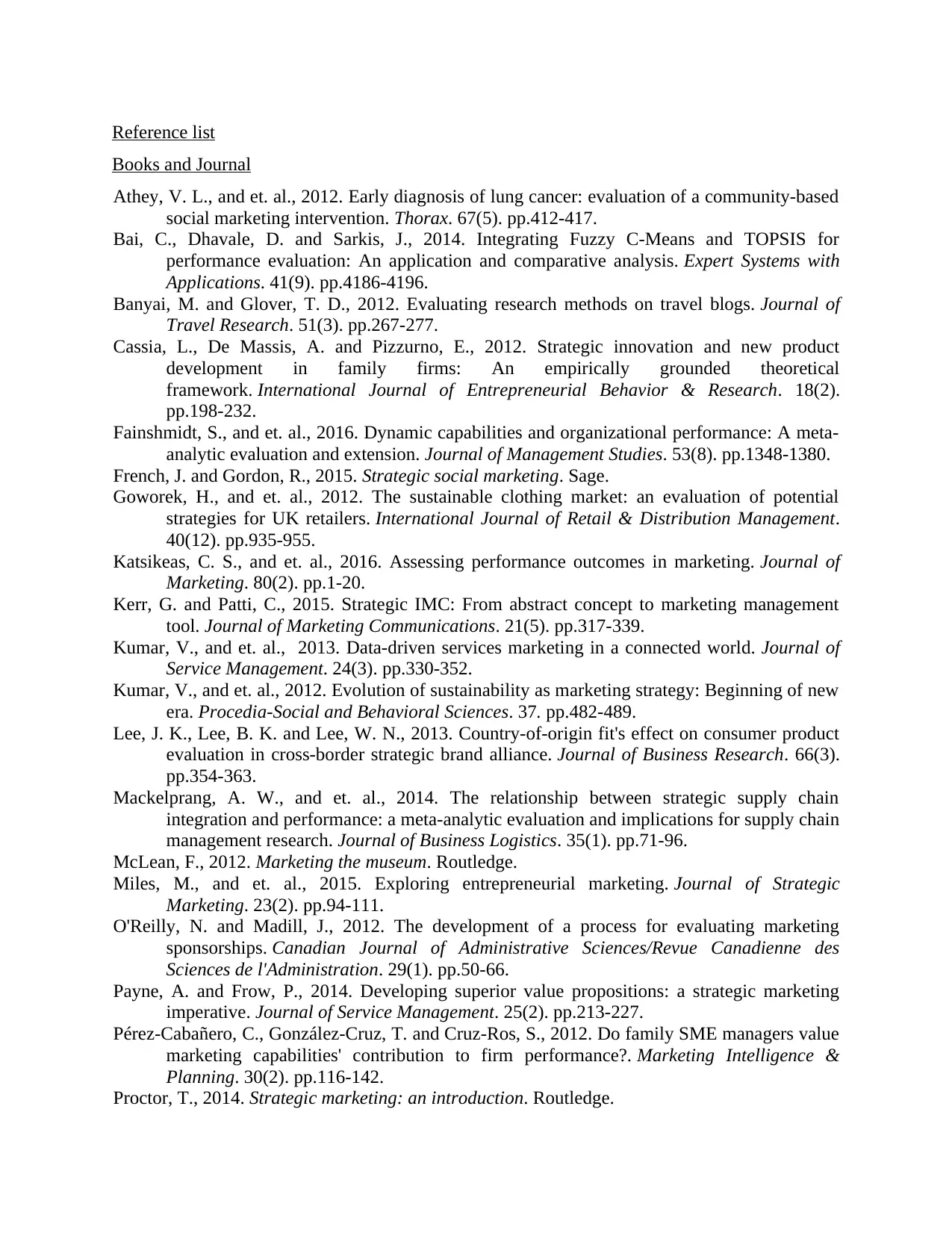
Reference list
Books and Journal
Athey, V. L., and et. al., 2012. Early diagnosis of lung cancer: evaluation of a community-based
social marketing intervention. Thorax. 67(5). pp.412-417.
Bai, C., Dhavale, D. and Sarkis, J., 2014. Integrating Fuzzy C-Means and TOPSIS for
performance evaluation: An application and comparative analysis. Expert Systems with
Applications. 41(9). pp.4186-4196.
Banyai, M. and Glover, T. D., 2012. Evaluating research methods on travel blogs. Journal of
Travel Research. 51(3). pp.267-277.
Cassia, L., De Massis, A. and Pizzurno, E., 2012. Strategic innovation and new product
development in family firms: An empirically grounded theoretical
framework. International Journal of Entrepreneurial Behavior & Research. 18(2).
pp.198-232.
Fainshmidt, S., and et. al., 2016. Dynamic capabilities and organizational performance: A meta‐
analytic evaluation and extension. Journal of Management Studies. 53(8). pp.1348-1380.
French, J. and Gordon, R., 2015. Strategic social marketing. Sage.
Goworek, H., and et. al., 2012. The sustainable clothing market: an evaluation of potential
strategies for UK retailers. International Journal of Retail & Distribution Management.
40(12). pp.935-955.
Katsikeas, C. S., and et. al., 2016. Assessing performance outcomes in marketing. Journal of
Marketing. 80(2). pp.1-20.
Kerr, G. and Patti, C., 2015. Strategic IMC: From abstract concept to marketing management
tool. Journal of Marketing Communications. 21(5). pp.317-339.
Kumar, V., and et. al., 2013. Data-driven services marketing in a connected world. Journal of
Service Management. 24(3). pp.330-352.
Kumar, V., and et. al., 2012. Evolution of sustainability as marketing strategy: Beginning of new
era. Procedia-Social and Behavioral Sciences. 37. pp.482-489.
Lee, J. K., Lee, B. K. and Lee, W. N., 2013. Country-of-origin fit's effect on consumer product
evaluation in cross-border strategic brand alliance. Journal of Business Research. 66(3).
pp.354-363.
Mackelprang, A. W., and et. al., 2014. The relationship between strategic supply chain
integration and performance: a meta‐analytic evaluation and implications for supply chain
management research. Journal of Business Logistics. 35(1). pp.71-96.
McLean, F., 2012. Marketing the museum. Routledge.
Miles, M., and et. al., 2015. Exploring entrepreneurial marketing. Journal of Strategic
Marketing. 23(2). pp.94-111.
O'Reilly, N. and Madill, J., 2012. The development of a process for evaluating marketing
sponsorships. Canadian Journal of Administrative Sciences/Revue Canadienne des
Sciences de l'Administration. 29(1). pp.50-66.
Payne, A. and Frow, P., 2014. Developing superior value propositions: a strategic marketing
imperative. Journal of Service Management. 25(2). pp.213-227.
Pérez-Cabañero, C., González-Cruz, T. and Cruz-Ros, S., 2012. Do family SME managers value
marketing capabilities' contribution to firm performance?. Marketing Intelligence &
Planning. 30(2). pp.116-142.
Proctor, T., 2014. Strategic marketing: an introduction. Routledge.
Books and Journal
Athey, V. L., and et. al., 2012. Early diagnosis of lung cancer: evaluation of a community-based
social marketing intervention. Thorax. 67(5). pp.412-417.
Bai, C., Dhavale, D. and Sarkis, J., 2014. Integrating Fuzzy C-Means and TOPSIS for
performance evaluation: An application and comparative analysis. Expert Systems with
Applications. 41(9). pp.4186-4196.
Banyai, M. and Glover, T. D., 2012. Evaluating research methods on travel blogs. Journal of
Travel Research. 51(3). pp.267-277.
Cassia, L., De Massis, A. and Pizzurno, E., 2012. Strategic innovation and new product
development in family firms: An empirically grounded theoretical
framework. International Journal of Entrepreneurial Behavior & Research. 18(2).
pp.198-232.
Fainshmidt, S., and et. al., 2016. Dynamic capabilities and organizational performance: A meta‐
analytic evaluation and extension. Journal of Management Studies. 53(8). pp.1348-1380.
French, J. and Gordon, R., 2015. Strategic social marketing. Sage.
Goworek, H., and et. al., 2012. The sustainable clothing market: an evaluation of potential
strategies for UK retailers. International Journal of Retail & Distribution Management.
40(12). pp.935-955.
Katsikeas, C. S., and et. al., 2016. Assessing performance outcomes in marketing. Journal of
Marketing. 80(2). pp.1-20.
Kerr, G. and Patti, C., 2015. Strategic IMC: From abstract concept to marketing management
tool. Journal of Marketing Communications. 21(5). pp.317-339.
Kumar, V., and et. al., 2013. Data-driven services marketing in a connected world. Journal of
Service Management. 24(3). pp.330-352.
Kumar, V., and et. al., 2012. Evolution of sustainability as marketing strategy: Beginning of new
era. Procedia-Social and Behavioral Sciences. 37. pp.482-489.
Lee, J. K., Lee, B. K. and Lee, W. N., 2013. Country-of-origin fit's effect on consumer product
evaluation in cross-border strategic brand alliance. Journal of Business Research. 66(3).
pp.354-363.
Mackelprang, A. W., and et. al., 2014. The relationship between strategic supply chain
integration and performance: a meta‐analytic evaluation and implications for supply chain
management research. Journal of Business Logistics. 35(1). pp.71-96.
McLean, F., 2012. Marketing the museum. Routledge.
Miles, M., and et. al., 2015. Exploring entrepreneurial marketing. Journal of Strategic
Marketing. 23(2). pp.94-111.
O'Reilly, N. and Madill, J., 2012. The development of a process for evaluating marketing
sponsorships. Canadian Journal of Administrative Sciences/Revue Canadienne des
Sciences de l'Administration. 29(1). pp.50-66.
Payne, A. and Frow, P., 2014. Developing superior value propositions: a strategic marketing
imperative. Journal of Service Management. 25(2). pp.213-227.
Pérez-Cabañero, C., González-Cruz, T. and Cruz-Ros, S., 2012. Do family SME managers value
marketing capabilities' contribution to firm performance?. Marketing Intelligence &
Planning. 30(2). pp.116-142.
Proctor, T., 2014. Strategic marketing: an introduction. Routledge.
Paraphrase This Document
Need a fresh take? Get an instant paraphrase of this document with our AI Paraphraser
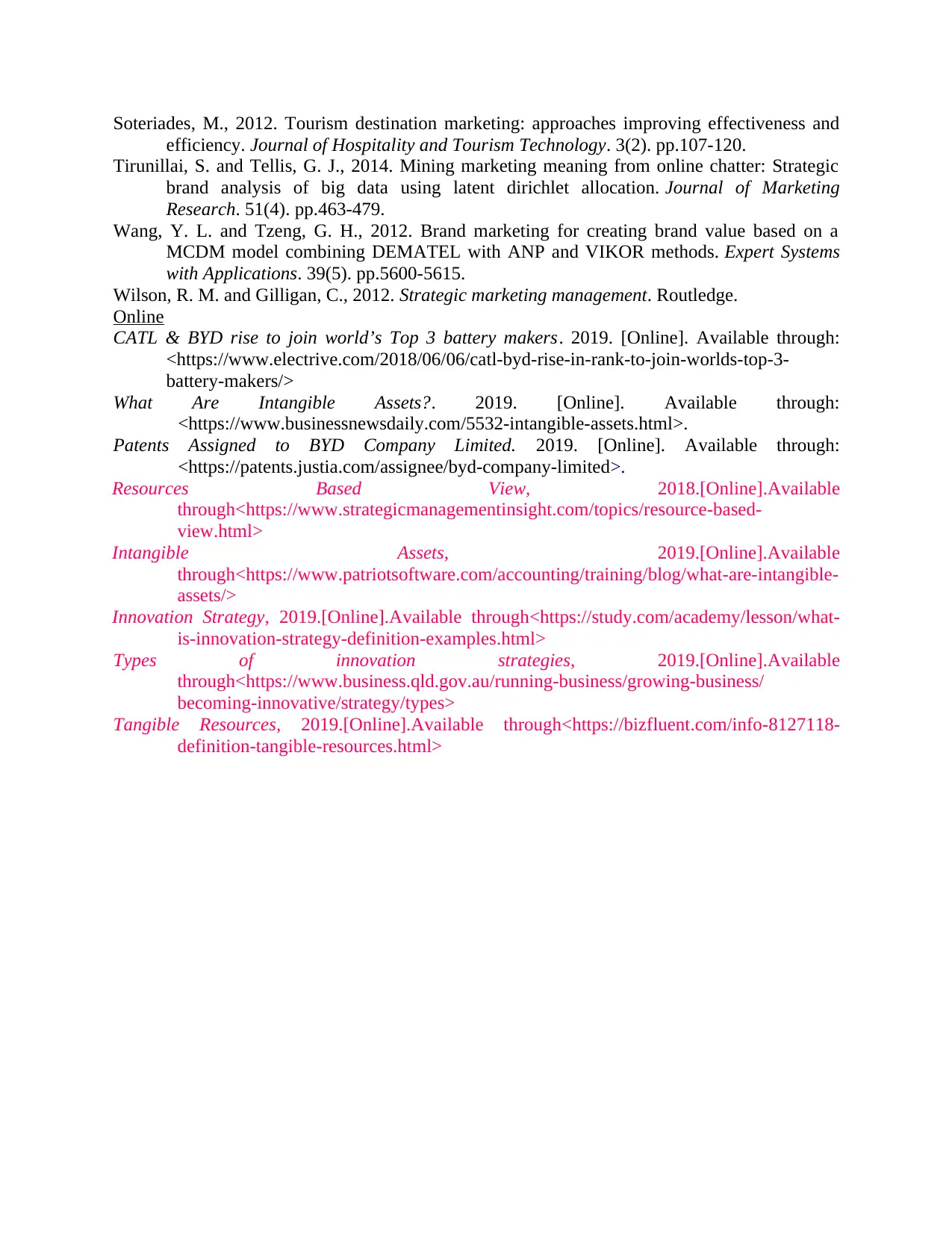
Soteriades, M., 2012. Tourism destination marketing: approaches improving effectiveness and
efficiency. Journal of Hospitality and Tourism Technology. 3(2). pp.107-120.
Tirunillai, S. and Tellis, G. J., 2014. Mining marketing meaning from online chatter: Strategic
brand analysis of big data using latent dirichlet allocation. Journal of Marketing
Research. 51(4). pp.463-479.
Wang, Y. L. and Tzeng, G. H., 2012. Brand marketing for creating brand value based on a
MCDM model combining DEMATEL with ANP and VIKOR methods. Expert Systems
with Applications. 39(5). pp.5600-5615.
Wilson, R. M. and Gilligan, C., 2012. Strategic marketing management. Routledge.
Online
CATL & BYD rise to join world’s Top 3 battery makers. 2019. [Online]. Available through:
<https://www.electrive.com/2018/06/06/catl-byd-rise-in-rank-to-join-worlds-top-3-
battery-makers/>
What Are Intangible Assets?. 2019. [Online]. Available through:
<https://www.businessnewsdaily.com/5532-intangible-assets.html>.
Patents Assigned to BYD Company Limited. 2019. [Online]. Available through:
<https://patents.justia.com/assignee/byd-company-limited>.
Resources Based View, 2018.[Online].Available
through<https://www.strategicmanagementinsight.com/topics/resource-based-
view.html>
Intangible Assets, 2019.[Online].Available
through<https://www.patriotsoftware.com/accounting/training/blog/what-are-intangible-
assets/>
Innovation Strategy, 2019.[Online].Available through<https://study.com/academy/lesson/what-
is-innovation-strategy-definition-examples.html>
Types of innovation strategies, 2019.[Online].Available
through<https://www.business.qld.gov.au/running-business/growing-business/
becoming-innovative/strategy/types>
Tangible Resources, 2019.[Online].Available through<https://bizfluent.com/info-8127118-
definition-tangible-resources.html>
efficiency. Journal of Hospitality and Tourism Technology. 3(2). pp.107-120.
Tirunillai, S. and Tellis, G. J., 2014. Mining marketing meaning from online chatter: Strategic
brand analysis of big data using latent dirichlet allocation. Journal of Marketing
Research. 51(4). pp.463-479.
Wang, Y. L. and Tzeng, G. H., 2012. Brand marketing for creating brand value based on a
MCDM model combining DEMATEL with ANP and VIKOR methods. Expert Systems
with Applications. 39(5). pp.5600-5615.
Wilson, R. M. and Gilligan, C., 2012. Strategic marketing management. Routledge.
Online
CATL & BYD rise to join world’s Top 3 battery makers. 2019. [Online]. Available through:
<https://www.electrive.com/2018/06/06/catl-byd-rise-in-rank-to-join-worlds-top-3-
battery-makers/>
What Are Intangible Assets?. 2019. [Online]. Available through:
<https://www.businessnewsdaily.com/5532-intangible-assets.html>.
Patents Assigned to BYD Company Limited. 2019. [Online]. Available through:
<https://patents.justia.com/assignee/byd-company-limited>.
Resources Based View, 2018.[Online].Available
through<https://www.strategicmanagementinsight.com/topics/resource-based-
view.html>
Intangible Assets, 2019.[Online].Available
through<https://www.patriotsoftware.com/accounting/training/blog/what-are-intangible-
assets/>
Innovation Strategy, 2019.[Online].Available through<https://study.com/academy/lesson/what-
is-innovation-strategy-definition-examples.html>
Types of innovation strategies, 2019.[Online].Available
through<https://www.business.qld.gov.au/running-business/growing-business/
becoming-innovative/strategy/types>
Tangible Resources, 2019.[Online].Available through<https://bizfluent.com/info-8127118-
definition-tangible-resources.html>

1 out of 21
Related Documents
Your All-in-One AI-Powered Toolkit for Academic Success.
+13062052269
info@desklib.com
Available 24*7 on WhatsApp / Email
![[object Object]](/_next/static/media/star-bottom.7253800d.svg)
Unlock your academic potential
© 2024 | Zucol Services PVT LTD | All rights reserved.





